Visit the photos tab of this site to see all of our photos from Siem Reap. Remember, hover over photos and wait for the drop-down menu to appear. Then, click on Cambodia.
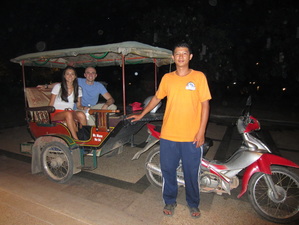 Joe and I in the back of a tuk tuk Siem Reap is a very small tourist town with a nice little downtown area. Since our hotel, Le Meridien Angkor, was a few kilometers away from the downtown area, Joe and I had to take a tuk tuk to get there.
What is a tuk tuk? It's Cambodia's version of a taxi. As you can see in the picture to the left, it's basically a cart that is hooked up to a motorcycle. It costs about $5 to hire a driver for a few hours. The drivers drop you off at your destination and then waits around for you so they can earn the roundtrip fare.
I know some of you might be thinking, "Wow, that doesn't look safe at all!" This mode of transportation actually isn't that bad. The drivers in Siem Reap, including those who drive cars and vans, drive really slowly and seem to be aware of their surroundings. Despite the sometimes chaotic traffic patterns (people didn't always adhere to the road lanes), I felt surprisingly safe in the tuk tuk. The only downfall is that the lack of windows and a windshield meant that you could easily get hit in the face by bugs. The video below gives you a taste of what it's like to ride in a tuk tuk.
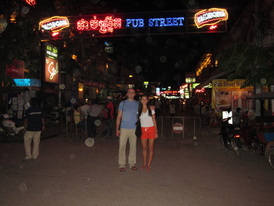 Joe and I at the end of Pub Street The main drag downtown is Pub Street. As the name suggests, it's a street full of bars and restaurants, and even a few clubs. There is a mix of international cuisine as well as Cambodian Khmer dishes. Two interesting things we saw (but didn't try) were crocodile burgers and Khmer style frogs (see photos below). I'm usually willing to try most foods, but these were not appealing to me at all!
I'll admit, Joe and I stuck to mostly western food both times we ventured downtown. Our first night, we ate at a Cambodian chain called The Blue Pumpkin. I'd venture to guess the cafe was started by someone from Europe. The food was good... I had a salad and Joe had a burger... and the desserts were fantastic. We enjoyed a mix of ice cream and sorbet. Our second night downtown, Joe and I ate at a Mexican restaurant. We caved because it's been a while since we had Mexican food, and it was especially appealing to have "normal" prices ($6 burritos in Cambodia vs $25 burritos here in Singapore!). It wasn't quite like our favorite places back in the states, but it was good!
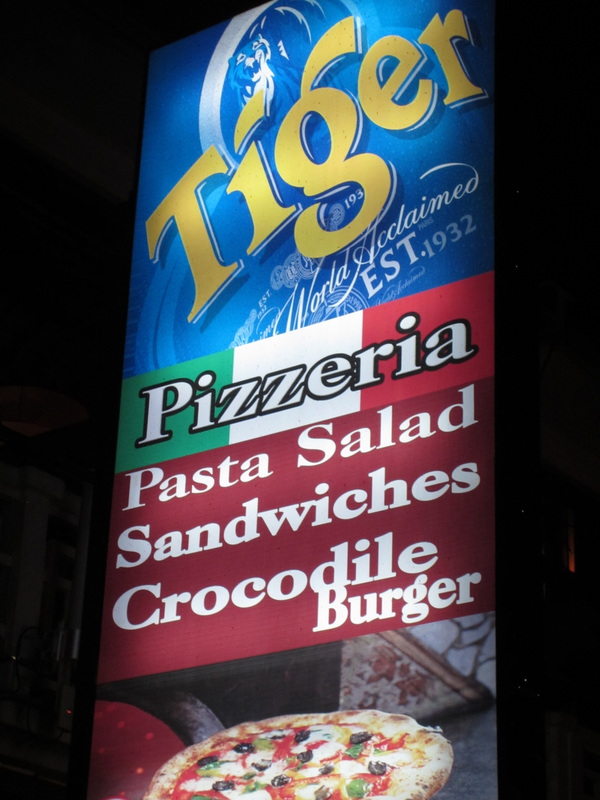 Crocodile burgers... interesting... | 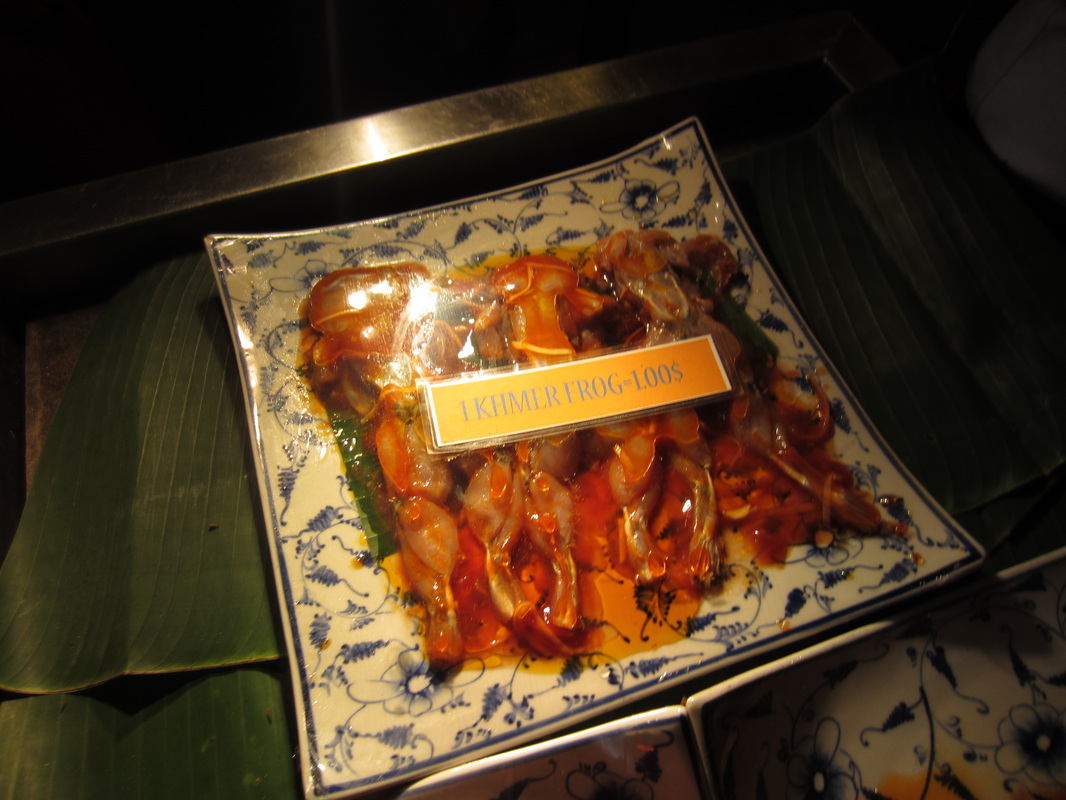 Khmer frogs | 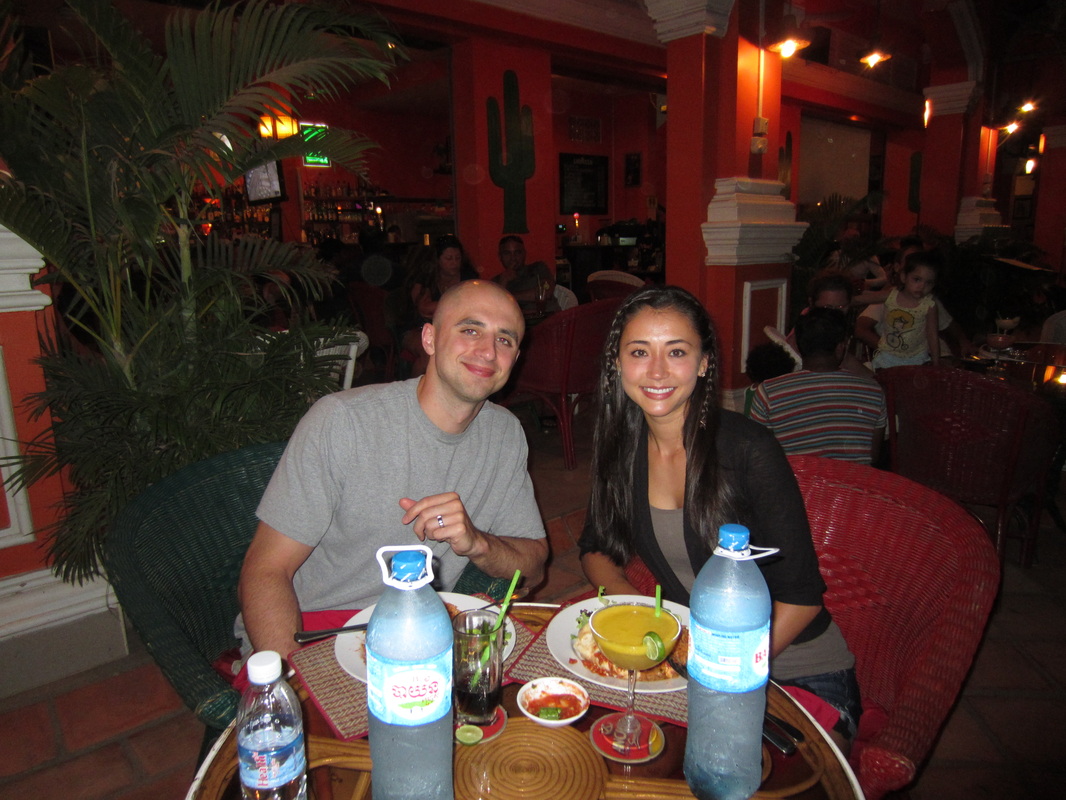 Enjoying Mexican food at La Vida restaurant |  Fish tank pedicure The downtown area has a ton of massage places right on the street... chairs literally outside where you can sit down and get a quick massage. Fish pedicures are also a big hit in Siem Reap. There seemed to be huge fish tanks on every corner. People sit on the edge with their feet in the tank and the fish swarm to the feet to eat the dead skin (gross!). Every time we walked by one of these, we were haggled to try it out. The salesmen offered us free beer to enhance the experience, but we weren't sold on the idea. I don't like the idea of sticking my feet into a tank with a whole bunch of other feet or letting fish nibble at me!
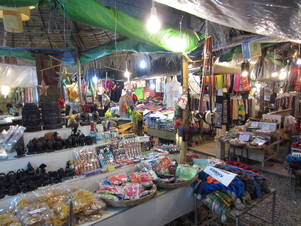 Night Market The main attractions of downtown, for me, were the markets. There are two main markets, the Old Market and the Night Market. All of the stalls offer the same sorts of things - cheap clothing, trinkets, and interesting food. The salespeople were really aggressive, trying to make a sell by pulling us into their stalls to look around. The sights and sometimes the smells were interesting.
Overall, we really enjoyed Siem Reap. In fact, Joe, who usually prefers only beach vacations, said he would go back to Siem Reap in the future.
Until next time, Siem Reap!
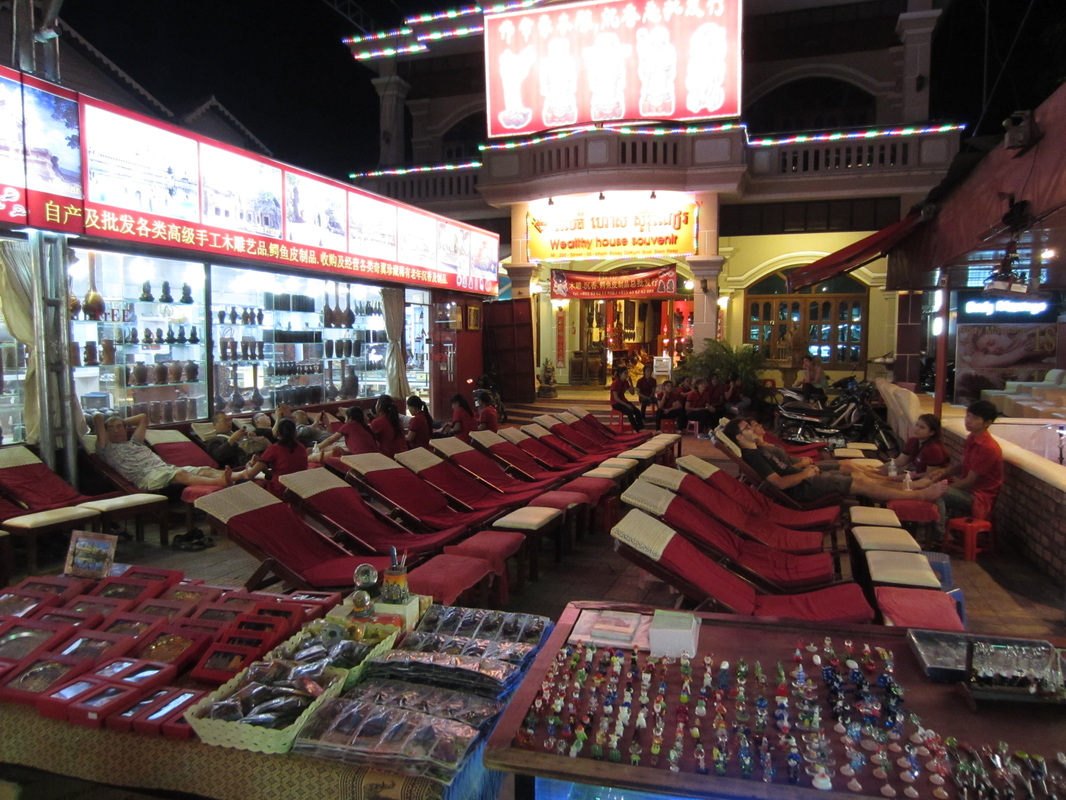 Massages on the street | 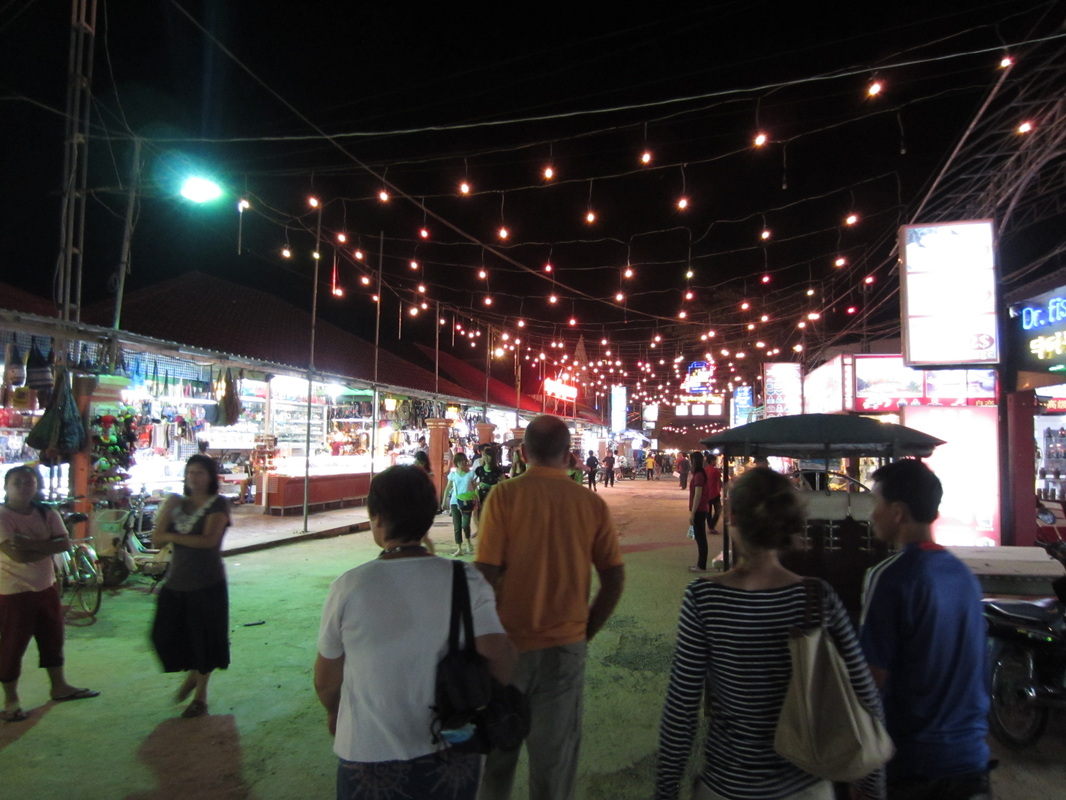 Road leading to the Night Market | 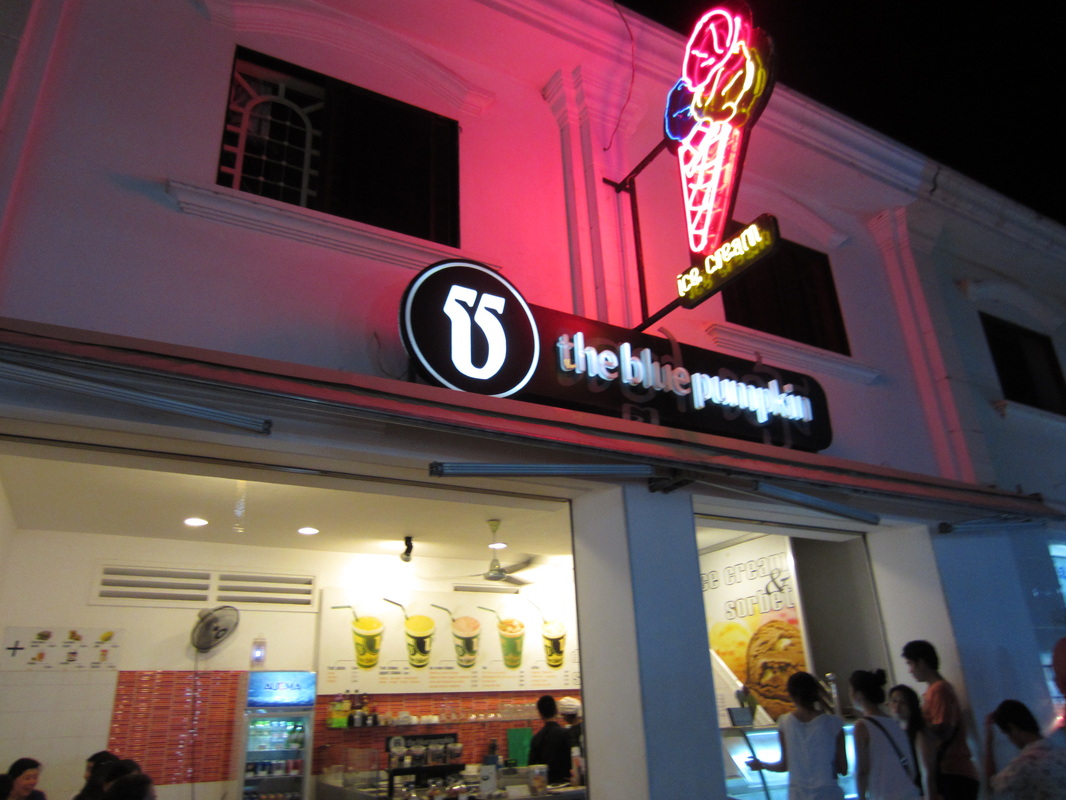 The Blue Pumpkin |
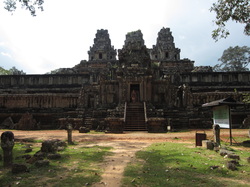 Ta Keo temple The Angkor Thom temple complex was the main attraction for the second half of our temple tour. However, we briefly made a pit stop on the way to see Ta Keo. Ta Keo's preservation is currently funded by China in coordination with UNESCO. The walls of of the temple have intricate Sanskrit writing carved into them. Savun explained that one of Cambodia's former kings used the walls to record good deeds done by citizens.
After exploring Ta Keo, we headed to Angkor Thom. In ancient times, Angkor Thom was a city surrounded by a big gate. The gate we passed through to get to the complex was incredible. Savun explained that it is called Victory Gate, and the king's army used it to enter the city if they were victorious in battle. There is also a gate that they used if they had been defeated. The roads leading up to both gates are lined with large demon statues (unfortunately, most of the statues were beheaded - again, done out of disrespect during war). The gates have a statue with four faces of Buddha at the very top.
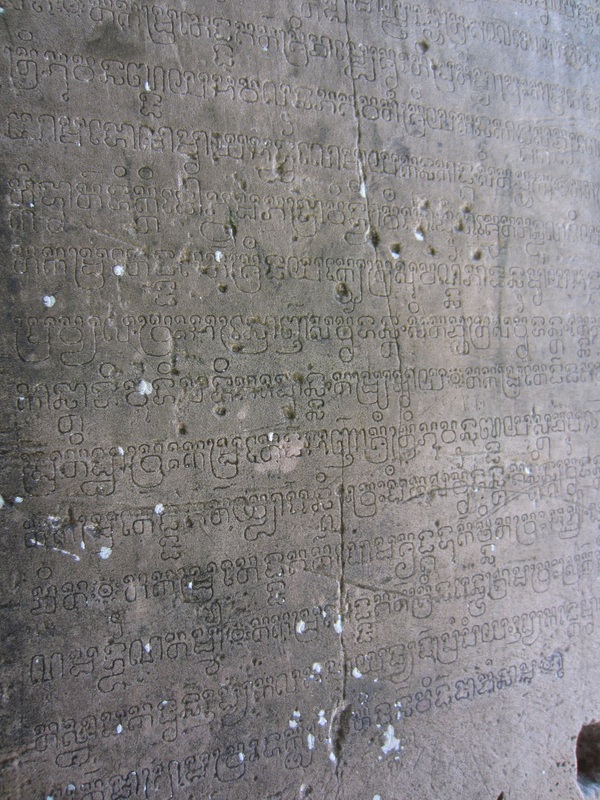 Sanskrit writing on wall at Ta Keo |  Statues lining the road to Victory Gate | 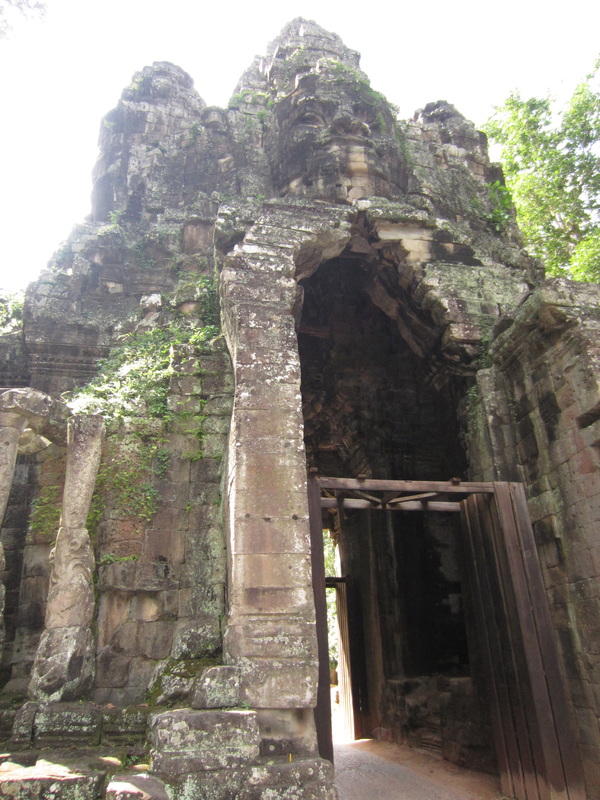 Victory Gate - see the faces of buddha at the top? There is one facing out each way | 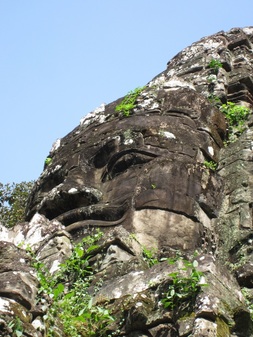 One of the faces of Buddha at Victory Gate Right inside the gate is the Baphuon Temple. At one time, Baphuon was a very regal structure where the king would greet visitors who came to Angkor Thom. Savun explained that a Chinese ambassador who visited the temple during the rule of the last Buddhist king (Hindu kings later took over) wrote about his experience, and the temple was documented as being a magnificent structure with large glass windows overlooking the city. It was pretty amazing to try and picture this... and amazing that records from the Chinese ambassador still exist!
Savun said the last Buddhist king was one of the last greatest kings of Cambodia, and really cared about their people. The Chinese ambassador wrote about his just manner of ruling, and how criminals were punished by being banished from the city and forced to live on their own outside of the city walls.
Right on the outskirts of Baphuon is a large pagoda with a statue of Buddha. When we passed it, Buddhist nuns were praying with a little girl and her family. Savun guessed the family might be from the countryside and had come to pray with the nuns because they needed a stroke of good luck. It was a very spiritual sight to see.
Besides the striking sights of the temples, Joe and I were floored by the sounds. The forests were very loud with what must have been thousands of cicadas. I captured the video below to give you an idea of how noisy it was!
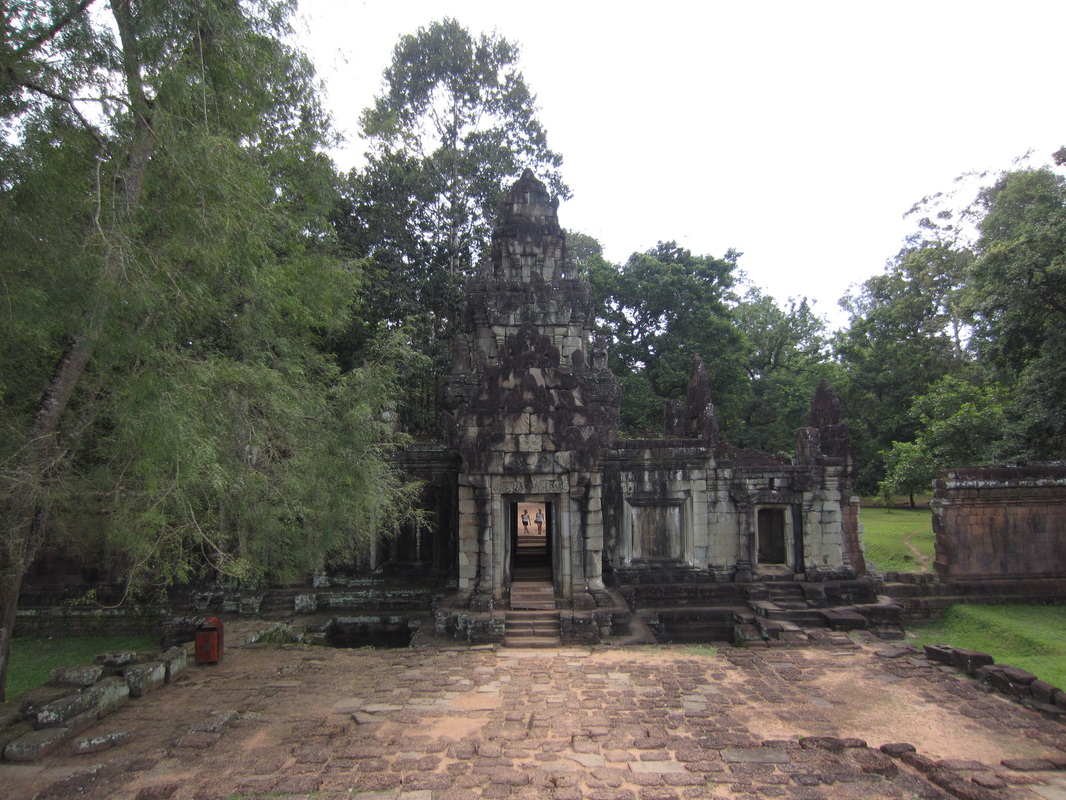 Baphuon |  Pagoda with Buddha statue between Baphuon and Bayon | 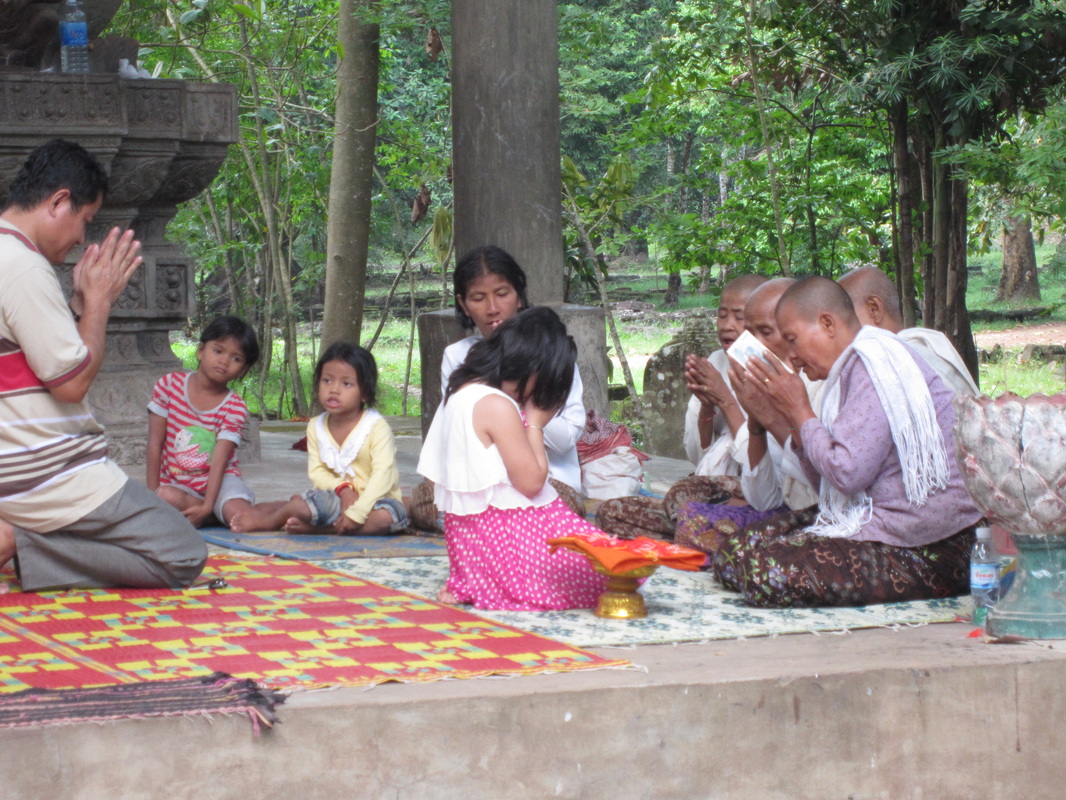 Buddhist nuns pray with a little girl | 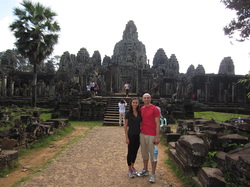 Bayon The final stop on our temple tour was Bayon. I would have to say that the most amazing aspect of Bayon to me were the multiple carvings of Buddha throughout the site. I can only image how long it must have taken to carve each one of the enormous faces!
Bayon also had really awesome carvings on its walls that depicted different wars. At first glance, the carvings of the people all looked the same to me. However, Savun pointed out small details, like headdress and facial hair, that depicted warriors from different countries - Cambodia, Vietnam, Thailand, and China.
Joe and I really enjoyed our temple tour. It was great learning about the history of Cambodia and surreal to be surrounded by such ancient sites!
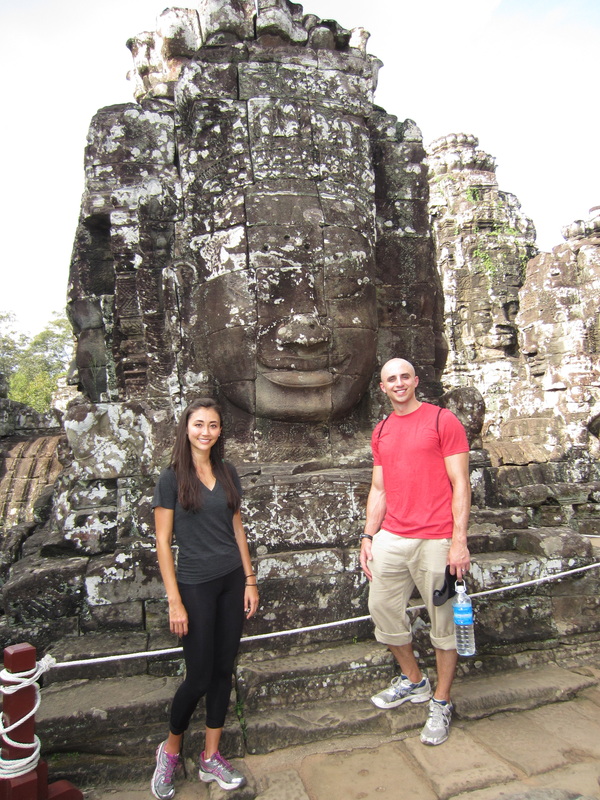 One of Bayon's many faces of Buddha | 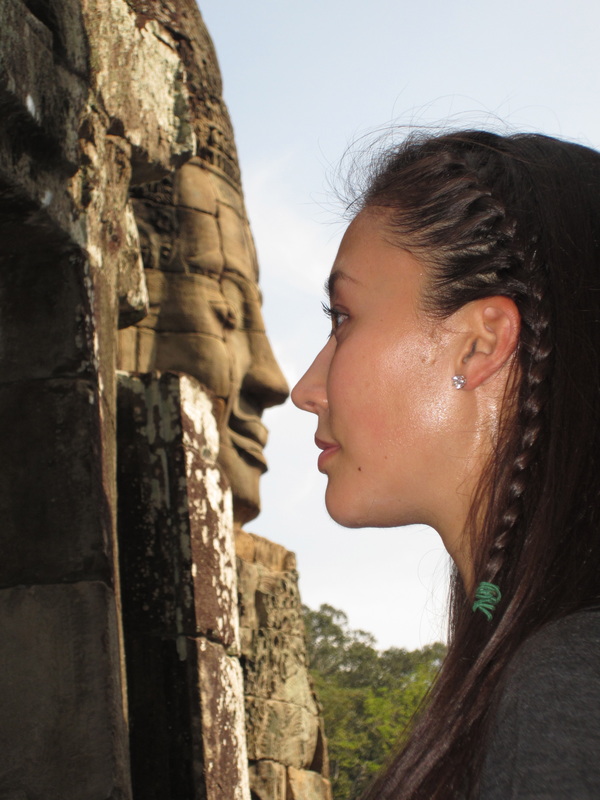 Nose to nose with Buddha | 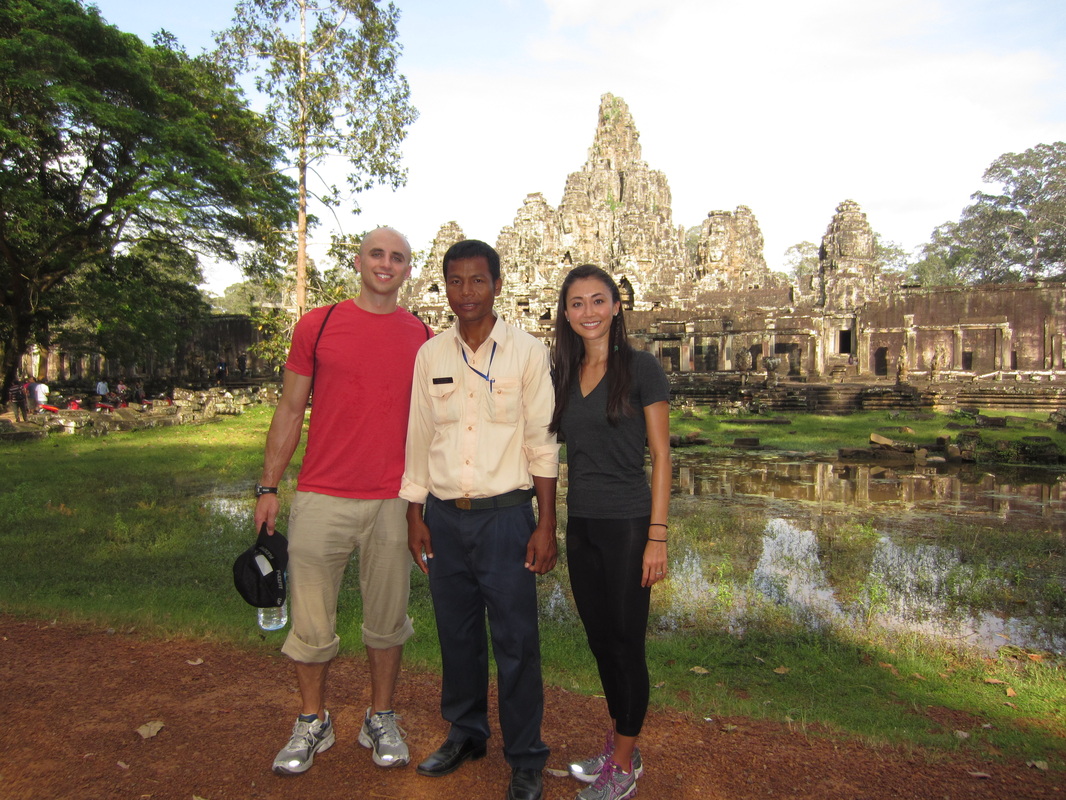 Joe, Savun, and I in front of Bayon |
 The front of Ta Prohm The next stop on our tour was Ta Prohm, a temple that is famous for its appearance in the movie Lara Croft: Tomb Raider. Savun explained that the temple was closed to the public for several hours everyday during the filming, and that the Cambodians were really excited about Angelina Jolie's visit to their country.
The temple is in pretty bad shape, so the Cambodian government is working with UNESCO to rebuild the world heritage site. Along with years of battles and pillaging that have destroyed the temple, the natural wildlife is also causing it to crumble. There are many large trees in the area that Savun described as being "soft trees." The trees are hollow with HUGE roots. These trees have grown around and within the temple, and their roots have pushed stones out of place, causing walls to collapse. Because the trees have grown into the temples, they are now part of the structure and cannot be removed without damaging the temple even further.
 Labeled stones laid out at the entrance | 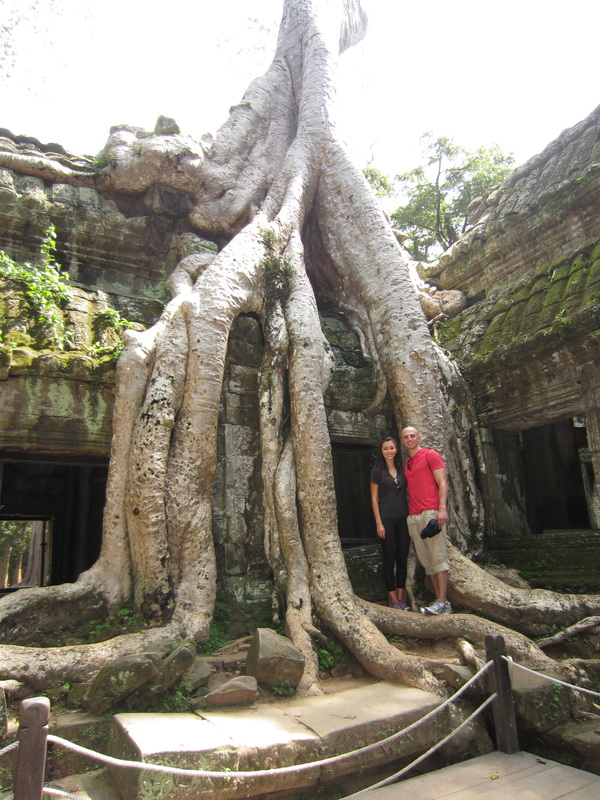 Huge tree and huge roots that have destroyed the temple | 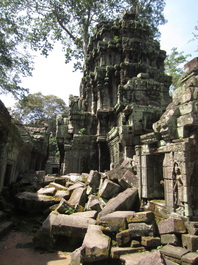 Stones that have fallen out of place | 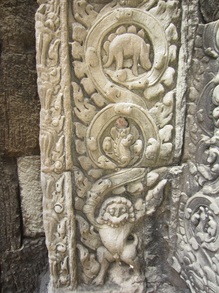 Carvings on Ta Prohm In order to rebuild the temple, archaeologists have carefully labeled each fallen stone with a number to create a sort of puzzle guide to help them reassemble them in the correct order. Archaeologists then move the stones out of the way so that they have clear paths within the temple. We saw many of the labeled stones at the entrance of the temple.
Since Ta Prohm is in far worse shape than Angkor Wat, the artwork wasn't as apparent. However, there were some columns that still had clear, intricate carvings intact. I found the carving pictured to the left to be quite interesting... doesn't it look like a dinosaur at the top? I wonder how the artists at the time knew about dinosaurs...
The visit to Ta Prohm made me want to watch Tomb Raider again. I'm curious to see if the temple looks drastically different in the movie compared to what it looks like in real life. As we left Ta Prohm, we stopped to donate money to a group of land mine victims. Each of them had been disabled in some way, but still managed to play an instrument despite their handicaps. It was a humbling and impressive sight.
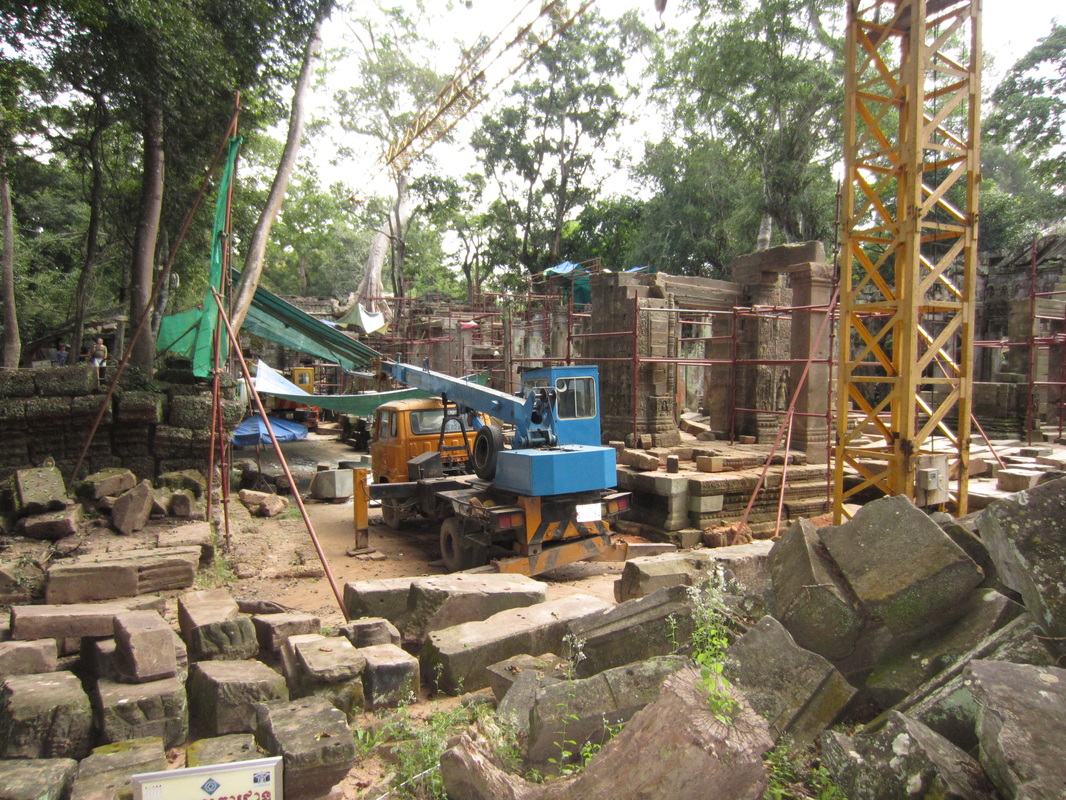 Construction in the middle of Ta Prohm | 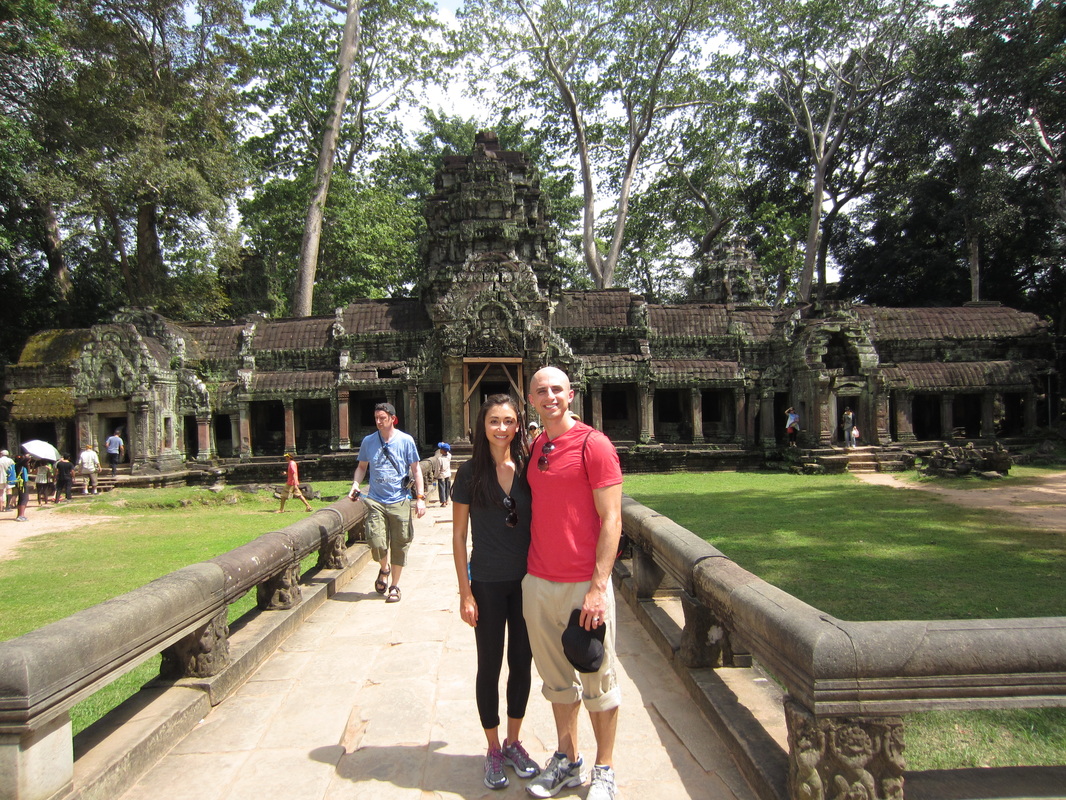 Joe and I posing at the back entrance of the temple |  Land mine victim band | 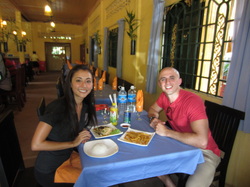 Lunch at Kolab Angkor Restaurant After Ta Prohm, Savun took us to a Cambodian restaurant called Kolab Angkor Restaurant where Joe and I had a chance to sample the local cuisine. The restaurant was quite charming, despite the fact that it was a simple building with no air conditioning along the side of a dirt path. Although the main dining room had clearly been built nicely for tourists, the restaurant appeared to have a side room for locals. I'm guessing that the restaurant has "local prices" for locals and higher prices for tourists. Still, the prices on our menu were extremely cheap! Many countries in Southeast Asia have establishments, such as museums, that charge locals a cheaper rate since they cannot afford tourist prices.
For about $20 (they use US dollars in Cambodia), we had a delicious feast! I tried stir-fried chicken with mushrooms. Joe had beef amok, which is beef and vegetables in a green curry sauce that is cooked and served in a coconut. It is a favorite dish among locals, although Savun told us most people prefer fish amok. We also split a plate of fries. It was a great meal and energized us for an afternoon of exploring more temples!
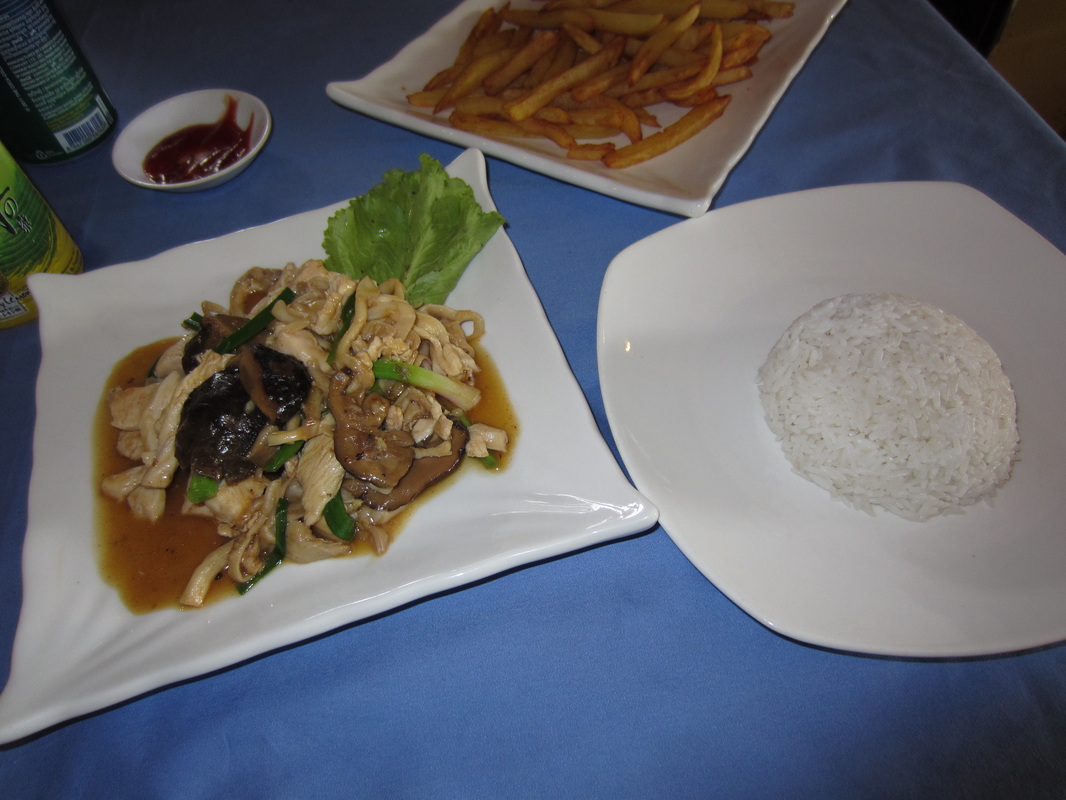 Stir-fried chicken with mushrooms |  Beef amok | 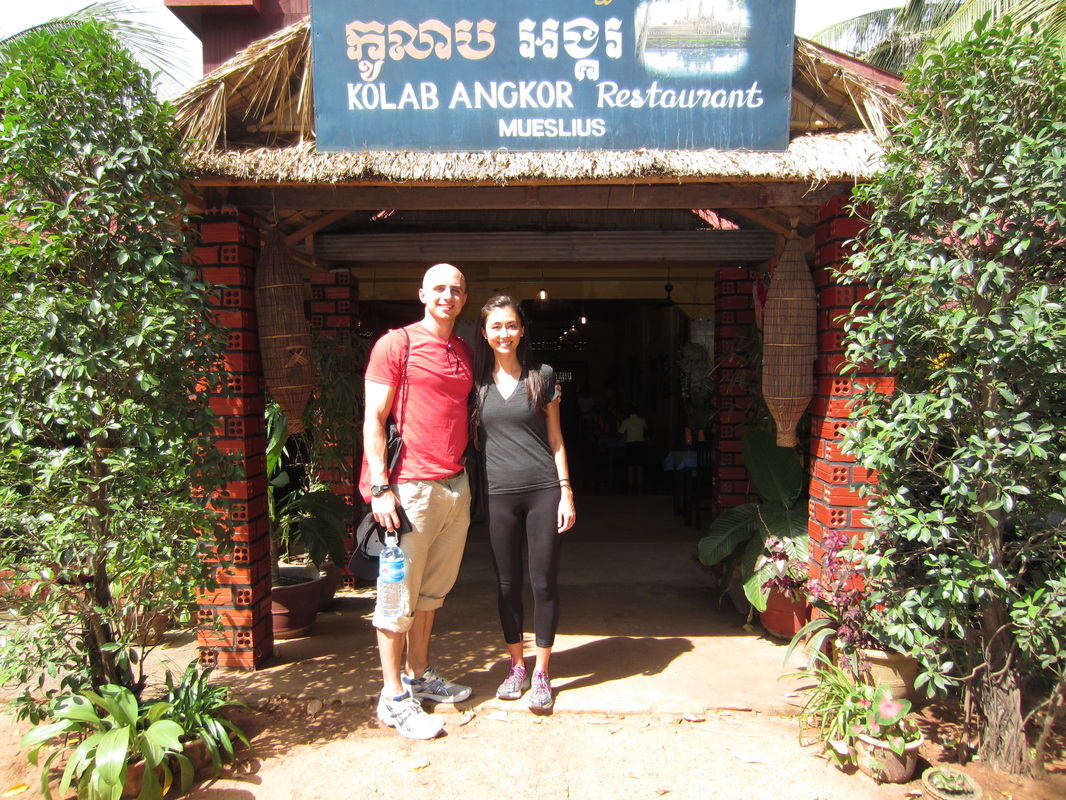 Posing in front of the restaurant |
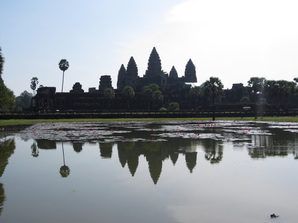 Angkor Wat's main temple Siem Reap was a lovely city. The people were extremely hospitable and nice (similar to people in Bali), the food was delicious, and the historical sites were incredible. Unfortunately, Joe and I only had a weekend to explore the city (I would have liked a few more days), but we made the most of it.
My first few posts about this trip are dedicated to the day we spent exploring the many temples of Siem Reap. This posting in particular only covers Angkor Wat... I realized as I started writing this that there is a lot to share!
Because of Siem Reap's rich history, Joe and I decided it was best to book a tour to learn about everything. We hired a guide through Angkortourguides.com and spent the day with a Cambodian man named Savun. I highly recommend Savun... he was great! His English was good and he knew a ton about the history of Siem Reap. Additionally, he grew up during the reign of the Khmer Rouge, and it was incredible to hear his stories of survival. It's amazing to think that he survived such a terrible event in history and now lives in a truly different era. In fact, he was very proud that his daughter is getting an education. She is sponsored by a family in Chicago who pays for her schooling (she attends a private high school). She hopes to be a lawyer someday and I hope it works out for her!
Anyway... I diverge... back to the temples! We started our day at Angkor Wat, probably the most famous temple in Siem Reap. It is an expansive temple that was built in the 12th century, and switched hands between Buddhist and Hindu leaders throughout history. I'll admit, I don't remember everything Savun told us about the temple, so I encourage you to read more about Angkor Wat on the web.
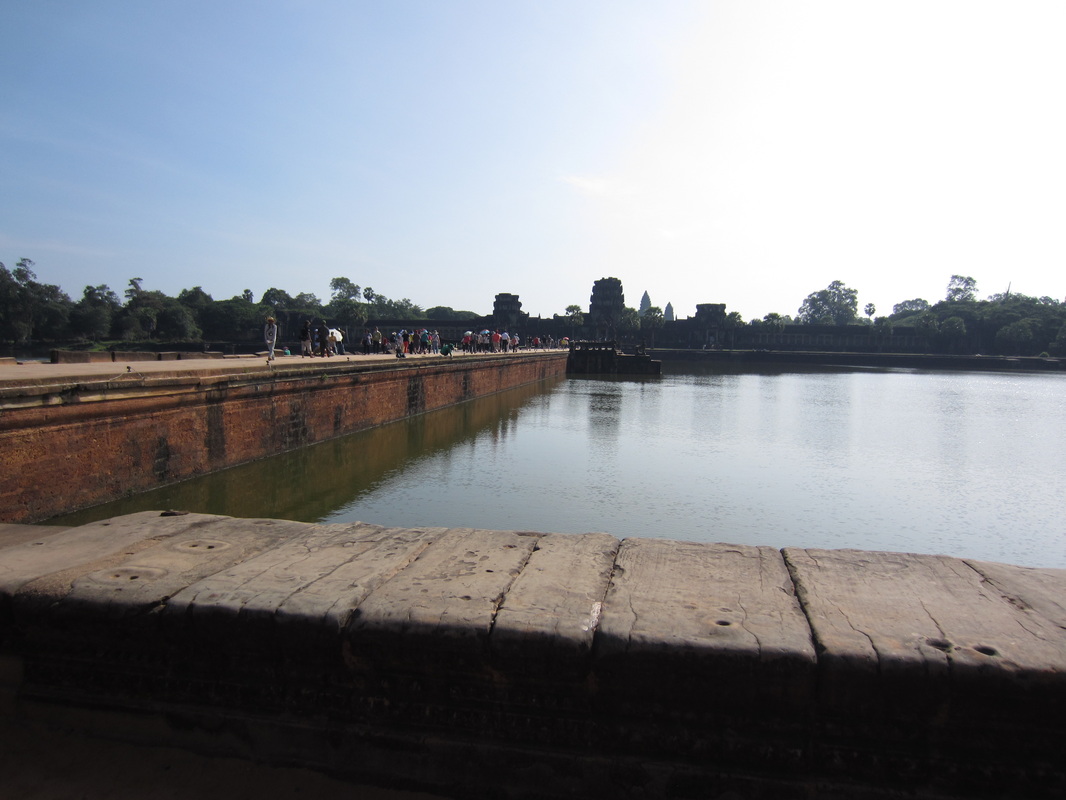 Angkor Wat's moat | 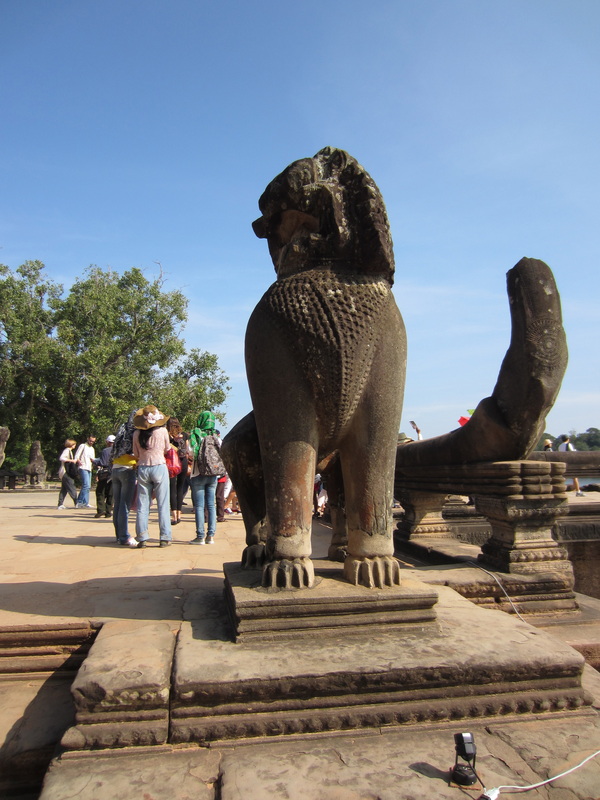 Lion statue (left) and snake statue (right) guarding the entrance of Angkor Wat | 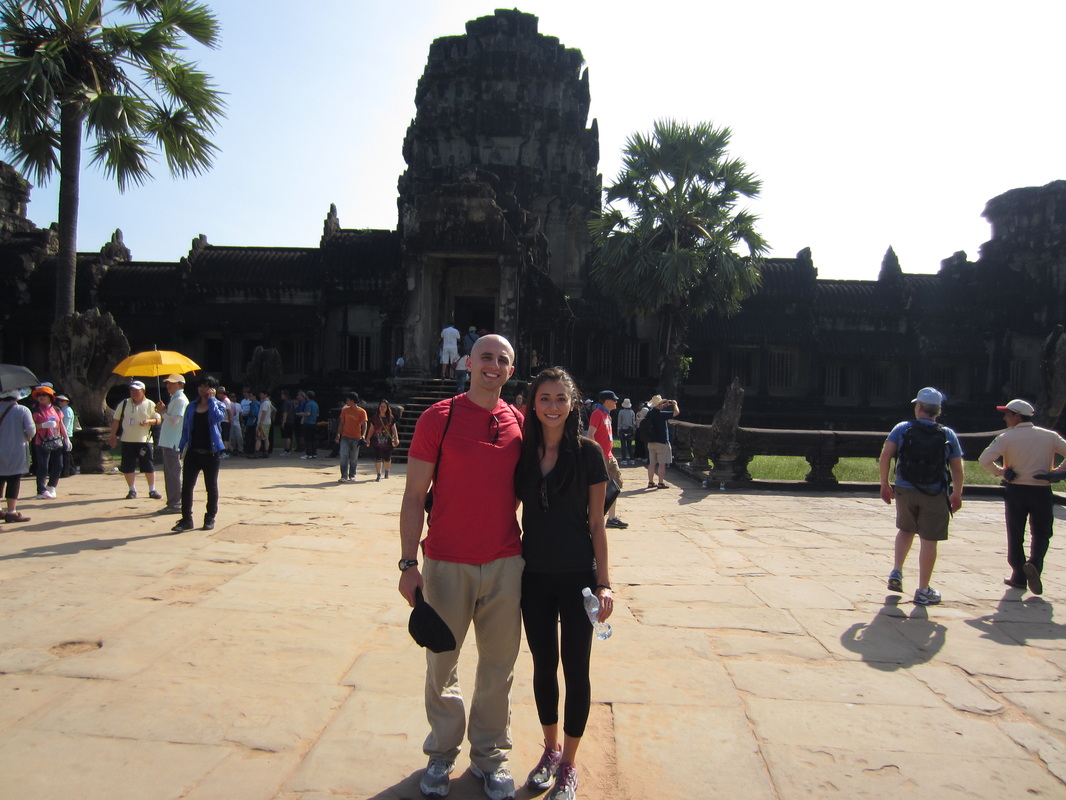 Joe and I strike a pose in front of the main entrance | 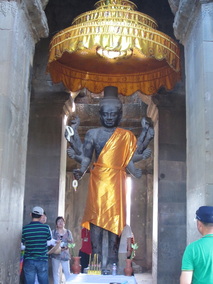 Hindu statue of the god Shiva There is a large moat around Angkor Wat, so we had to walk across a bridge to get to the main complex. The bridge is guarded by lion statues as well as snake statues, whose bodies once extended all the way across the bridge. Unfortunately, much of Angkor Wat has fallen apart, and we had to imagine what the temple once looked like. We learned that the temple was destroyed by the many wars Cambodia has endured. In fact, there are bullet holes on the exterior of the temple. During wars, the temples were raided for goods and statues were beheaded out of disrespect. The temple was also destroyed by villagers who pillaged the stones to build their own homes. It's sad that people don't realize the significance of history until it is too late!
The walls of the temple are elaborately decorated with stone carvings that depict different stories, mostly of wars. Many of the ornate designs have been worn down by the weather and mistreatment, but the ones that are still in tact are spectacular. The artists responsible for them were extremely talented. Most of the etchings had a faint black color to them, but some of the walls also had a faint red color to them. We learned that when the Buddhists took over Angkor Wat, they colored the walls red.
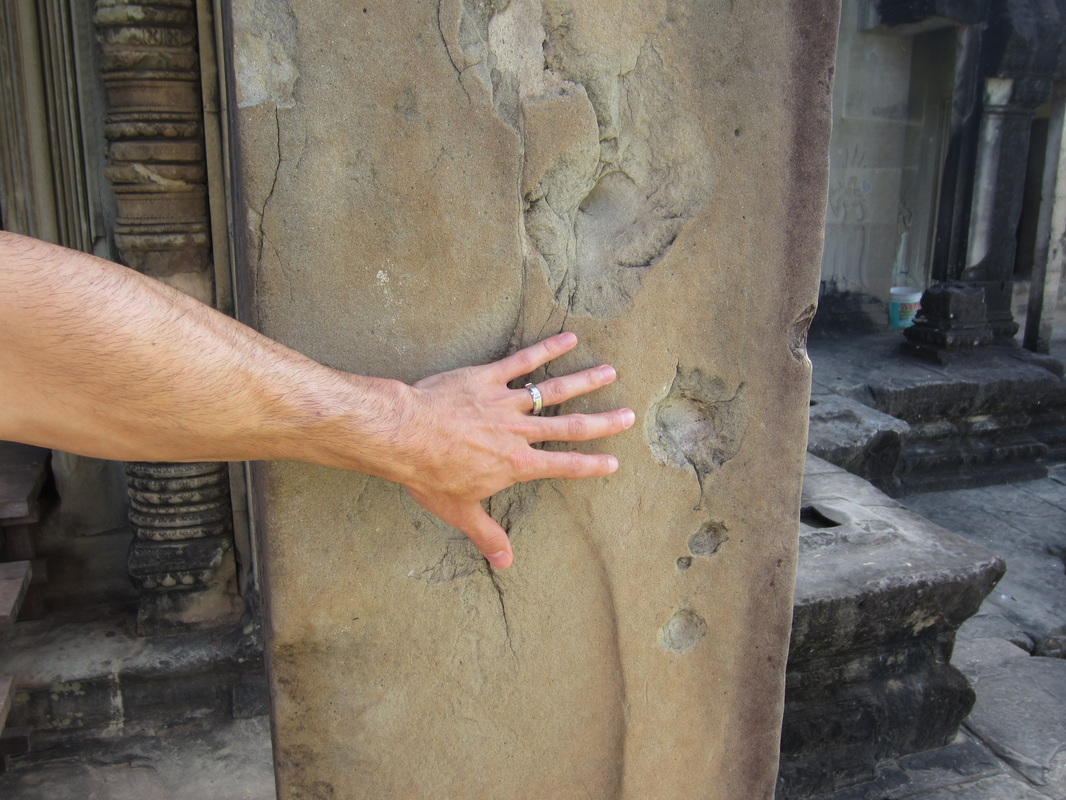 Bullet holes... and Joe's hand to give you an idea of how big the holes are! | 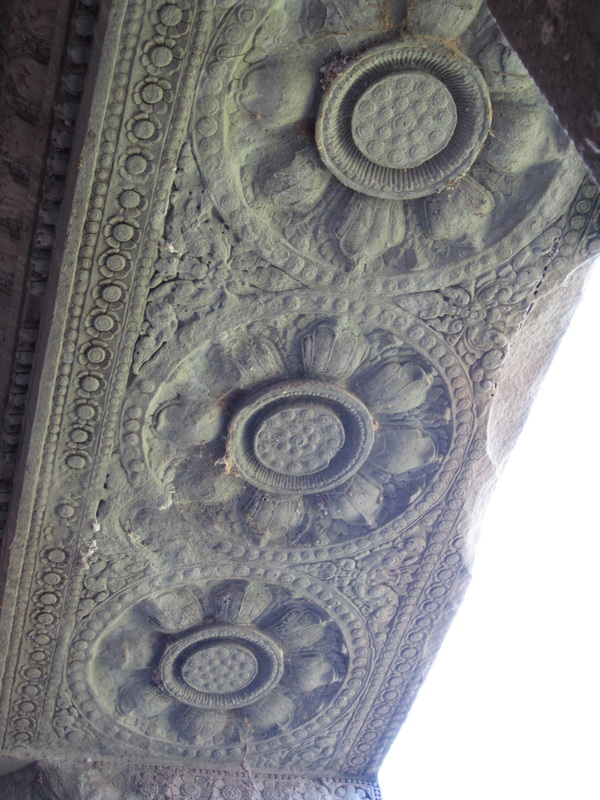 Lotus carvings on ceiling | 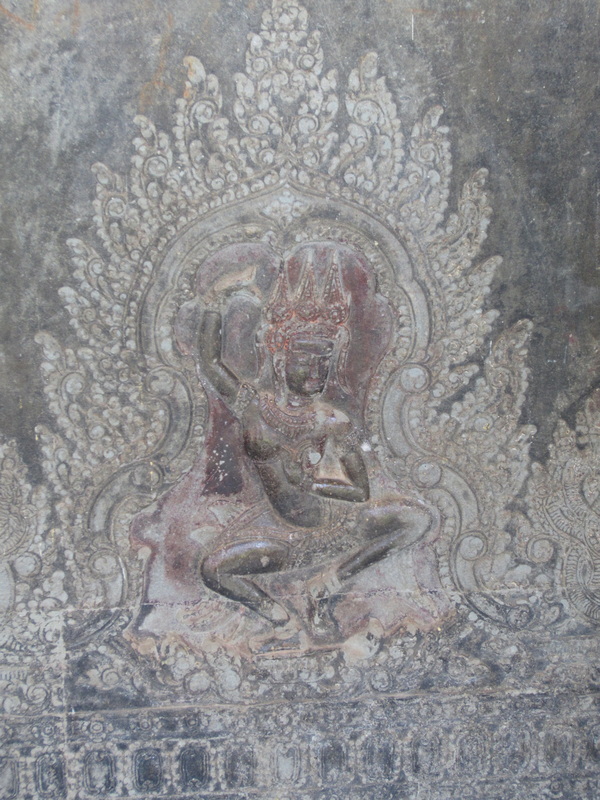 Carving of a Hindu dancer... see the faint red color on the wall? | 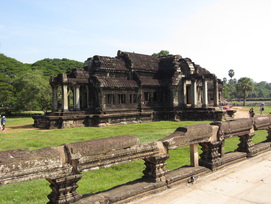 Library for priests We trekked past several small buildings on the grounds of Angkor Wat as we headed towards the main complex (yes, all of the pictures I've shown you so far aren't even of the main building!). We learned that these were once libraries for the temple's priests, who were the scholars of Angkor Wat.
Before exploring the main complex, we stopped at a little rest area near Angkor Wat's cemetery. The space had both a pagoda for Buddhist monks as well as their living quarters. We saw young boys with shaved heads, and learned that these were monks-in-training.
We also saw a man cutting grass by hand on the grounds! Savun explained that all of the grass at Angkor Wat is cut by hand (although he didn't say why). I was blown away by this!
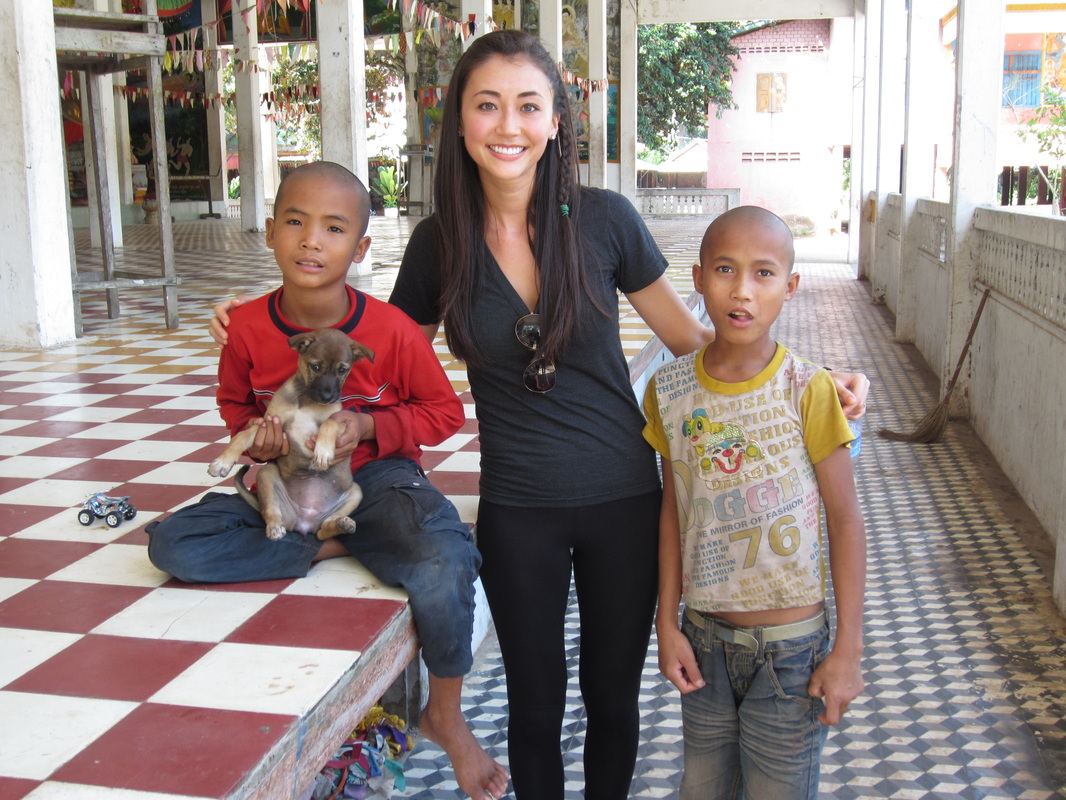 Photo opp with two young monks | 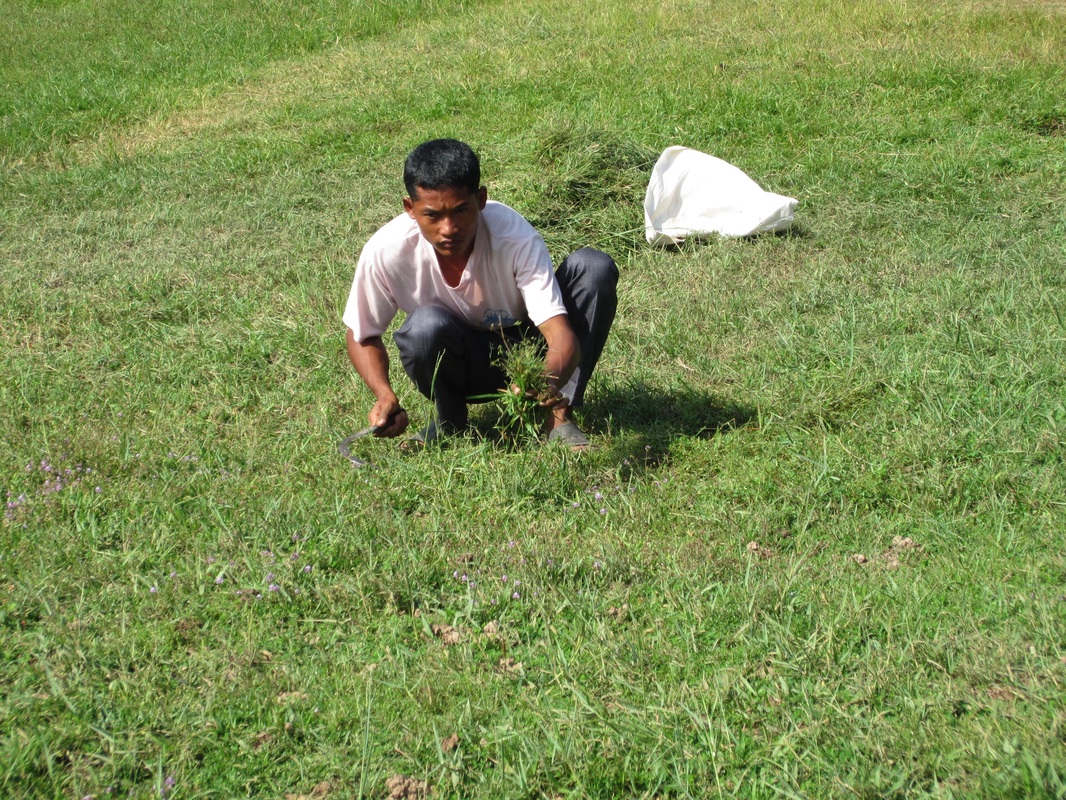 Man cutting grass by hand | 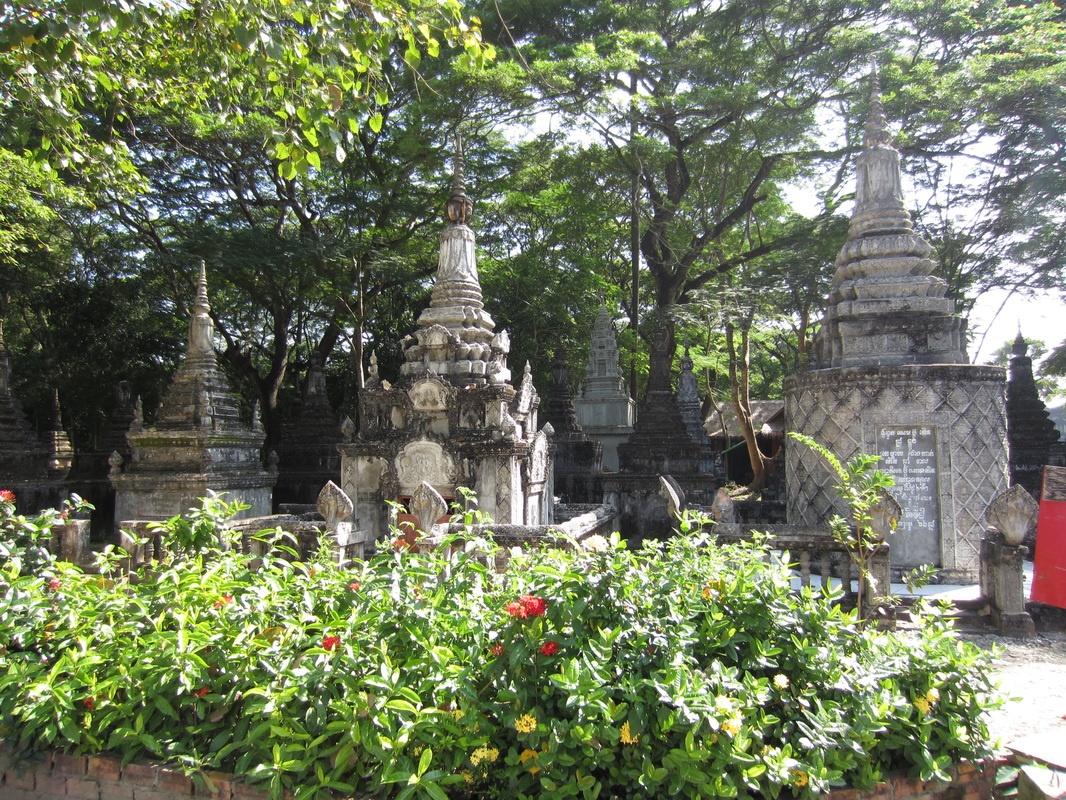 Angkor Wat cemetery | 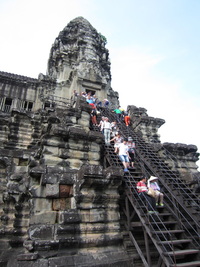 Climbing to the top of Angkor Wat The next stop on the tour was the main complex of Angkor Wat. It is a three-story edifice with an extremely steep climb to the top. Joe and I were amazed by all of the elderly tourists who had the energy for the trek (there were many of them!).
The view from the top was great. We saw several open spaces on the ground that we later learned were pools for the king so that he could cleanse himself before doing holy activities.
After getting our fill of the view and of photos, we made the scary journey back down the steep stairs. My palms were sweaty, especially when nearly everyone in front of us stopped midway to have people at the bottom take photos of them on the stairs. Ah! I just wanted to make my way down quickly!
 View from the top | 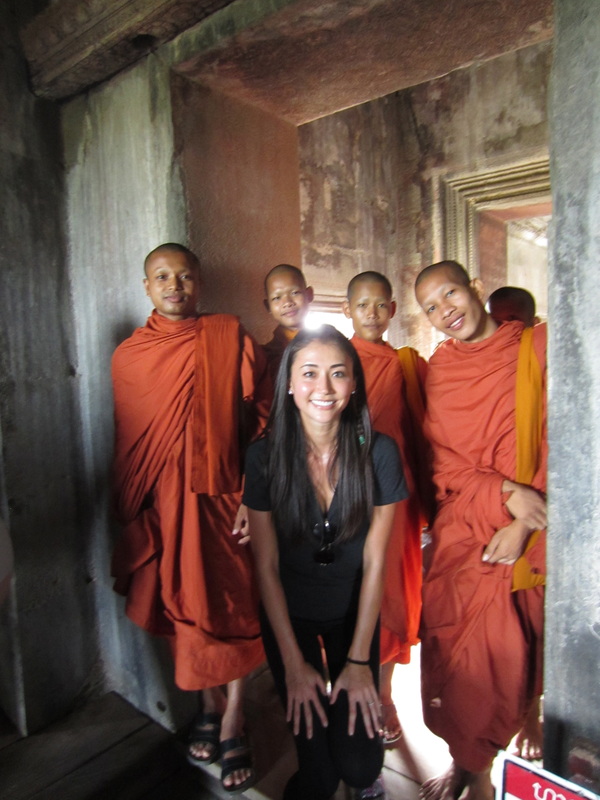 Monks visiting the temple | 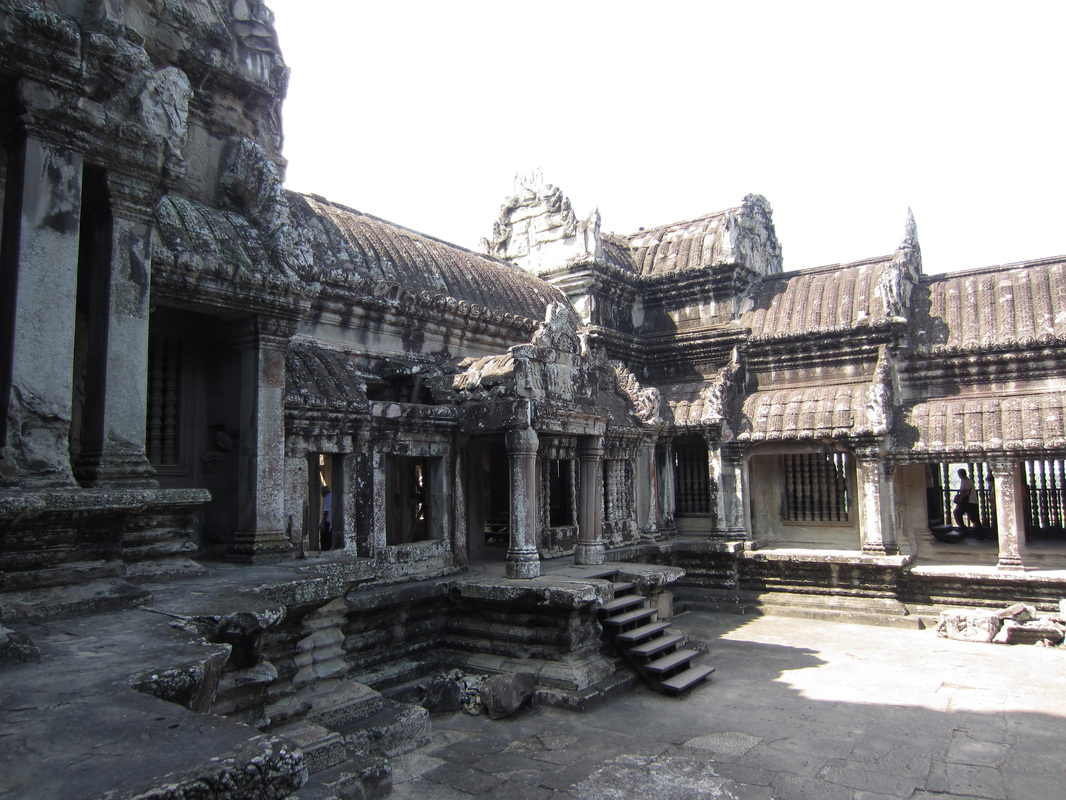 One of the king's many pools... no water in them now! | Once at the bottom, we had a chance to take photos with Cambodians wearing traditional costumes. They even helped Joe and I pose with Cambodian dance hands.
Angkor Wat was incredible with an amazing, rich history! I'm glad we had the opportunity to visit the temple. Next stop on our temple tour was Ta Prohm... stay tuned! 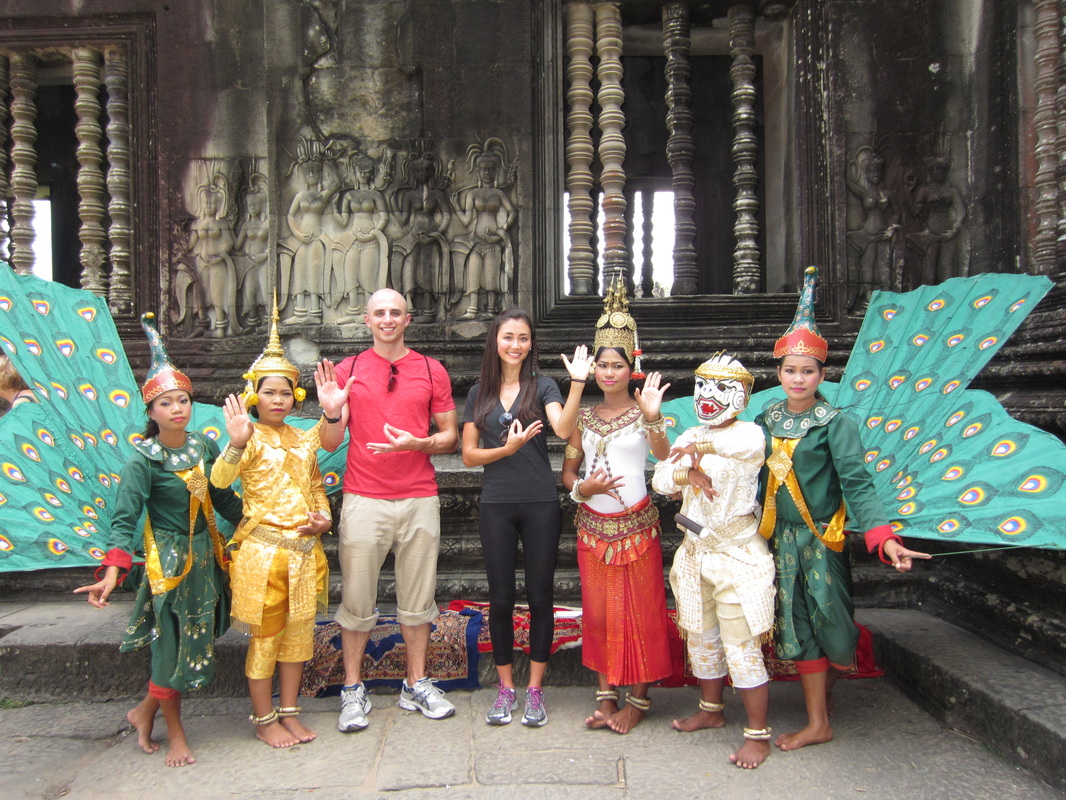 Joe and I pose with Cambodian dancers | 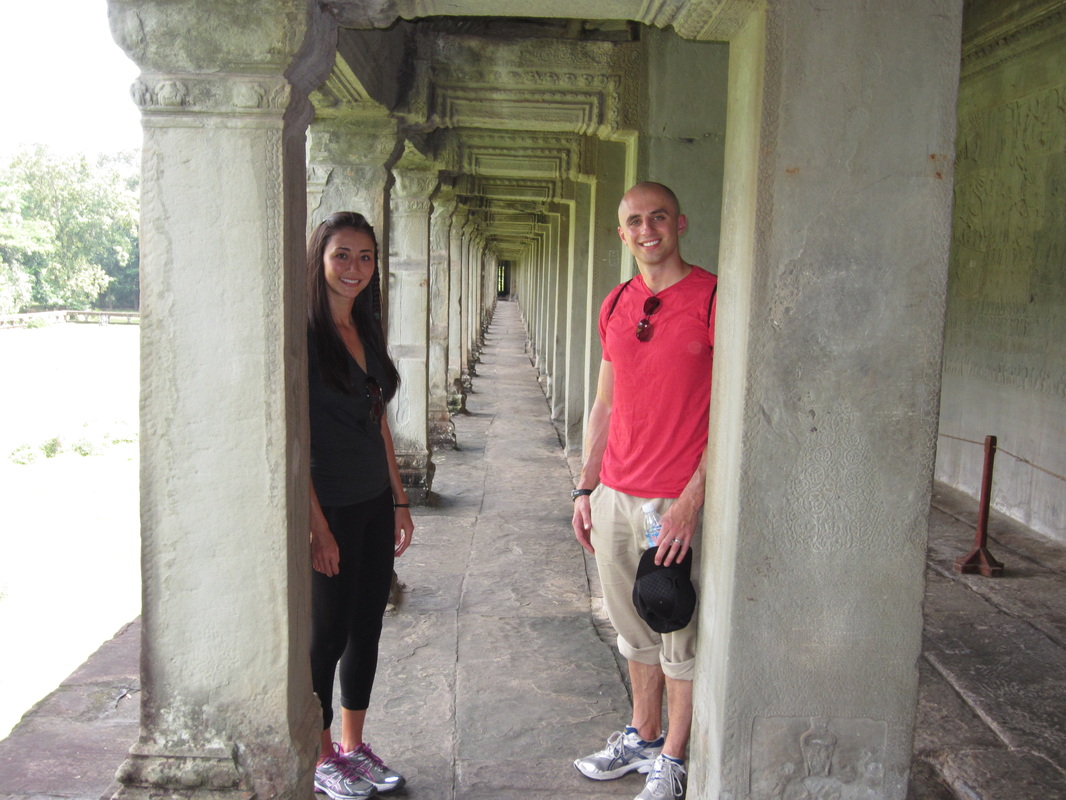 One of Angkor Wat's many corridors |
Joe and I are heading to Siem Reap, Cambodia for a quick weekend trip. A visit to Angkor Wat is at the top of our sightseeing list. I've read and heard many great things about the site. See you back here next week with some updates!
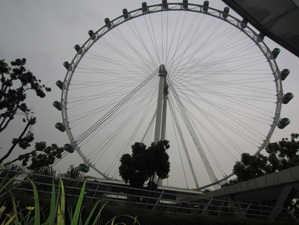 The Singapore Flyer This posting is long overdue! A few weeks ago, my friend and colleague from Towers Watson, Kate Davis, was in Singapore and we had a chance to meet up. It was great seeing Kate and meeting her boyfriend Mike. We decided to experience Singapore from a different view, and booked a ride on the Singapore Flyer, the country's famous ferris wheel.
The flyer is massive and its cars are entire rooms, big enough for at least 15 people. Tourists can book a variety of themed cars based on their interests. I even saw an advertisement for a wedding car in which you can get married on the Flyer! Kate, Mike, and I selected the Singapore Sling car and got to enjoy the delicious drink on board.
The Flyer spins very slowly - it takes about 30 minutes to make a rotation and you get one round on the ride - but our time on the ride seemed to fly by! We had a great view of the city (despite the gray, cloudy day) and shared our experiences of Southeast Asia (Kate and Mike live in Hong Kong).
Thanks for a great visit, Kate! Can't wait to see you again soon!

The Singapore Sling car
|
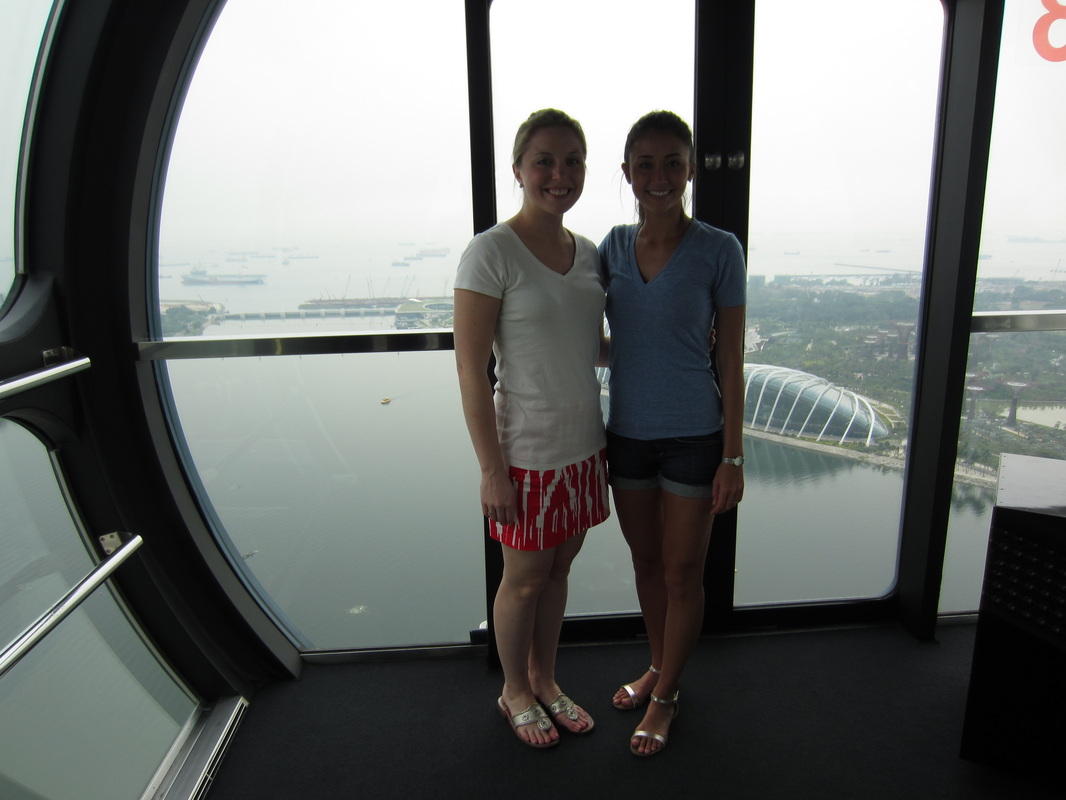
Kate and I strike a pose high above Singapore
|
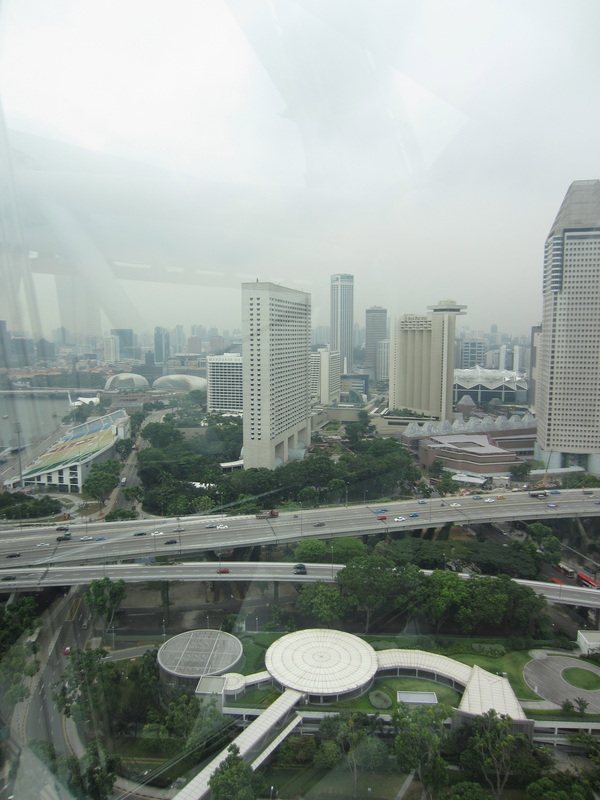
View of Singapore
|
Photos of our trip to Rawa are now posted under the photos tab. Hover over the tab and select Malaysia to see them.
As a side note, Joe was excited to see the bags pictured below on the pier of Rawa. He works for BASF and it was very random to see the company's products all the way out in the middle of the ocean!
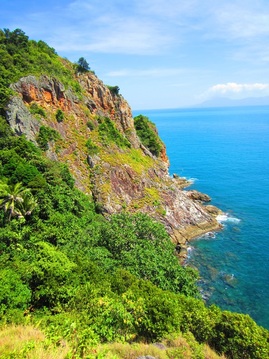 The other side of Rawa We started day two in Rawa with a jungle trek up to the top of the island. The trail was nicely laid out for us with concrete steps that led the way (and provided an exhausting gluteal workout as well!).
The view from the top of Rawa was spectacular as you can see in the photo to the left. The island is really narrow, so we could see the different landscapes of the opposite sides from one vantage point. The side we stayed on has the island's only beach, and the water is fairly calm. The side opposite the beach is very rocky and the current is extremely strong (as we later found out in the day... more to come on this later in the story).
After taking in the view from the top, we made our way back down the hill and took a different path that goes around the base of the island. We discovered that Rawa Safaris is quite expansive, with villas along the hillside.
While exploring this part of the island, we ran into the manager of the resort (his name is Tom). I asked him about the prices of the villas (because they looked really modern and nice), and surprisingly, he asked, "Do you want to try one out?" At first, I thought Tom was joking because he has a dry, almost sarcastic attitude. However, he wasn't. We later discovered this was a blessing.

View of our beach from above
|

The trail around the island
| Before moving into our new digs, Joe and I decided to have an adventure and went kayaking in the ocean. At first, the experience was great. We took off from our side of the island into the calm water, enjoying the scenery. We joked about who could paddle faster (of course, this was Joe's forte) and set a goal of going around the entire island. This was a bad idea.
When we made it to the opposite side of the island, we discovered the water was extremely choppy and it was difficult to control the kayak. It was eerie being away from the civilized side of the island and it felt almost as if we were lost at sea. And to top things off, poor Joe got seasick from being thrown around, leaving (poor) me with the responsibility of getting us back to the other side. My muscles ached and the skin on my hands was rubbed raw from the paddles, but I pushed through. And, Joe avoided hurling into the ocean (we were afraid it might attract sharks!). It was both a triumph and a relief when we finally reached home base! 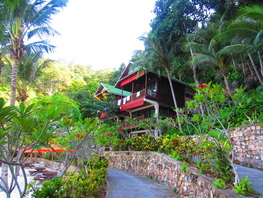 Our villa on the hill After this adventure, all I wanted was a nice air conditioned room to relax in... and luckily, the villa we moved into provided this! The villas are a newer addition to the resort, and are very nice. Our new room was a stark difference from our bungalow on the beach! We celebrated as we cranked the air down to 18 degrees celcius. If you plan to visit Rawa, I recommend booking a villa. Thank goodness I asked about it!
To end the active day, we relaxed on the pier and enjoyed the ocean and the stars. It was a serene and romantic way to end our trip!
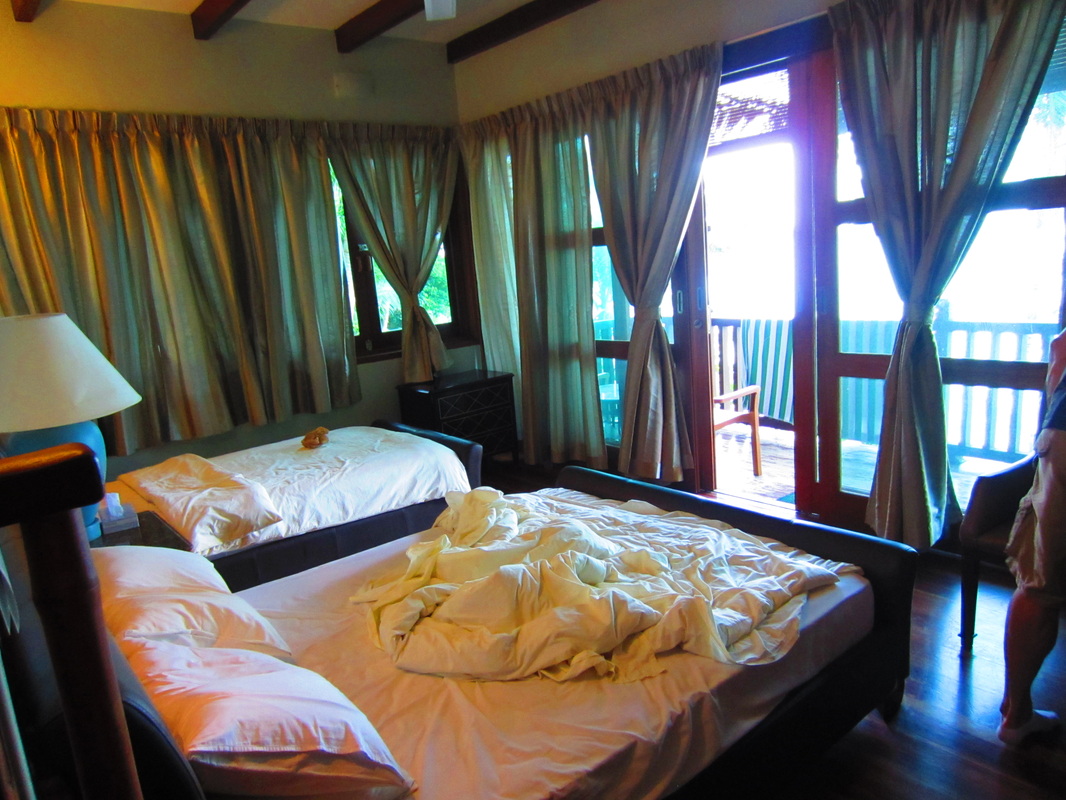
Our new room
|
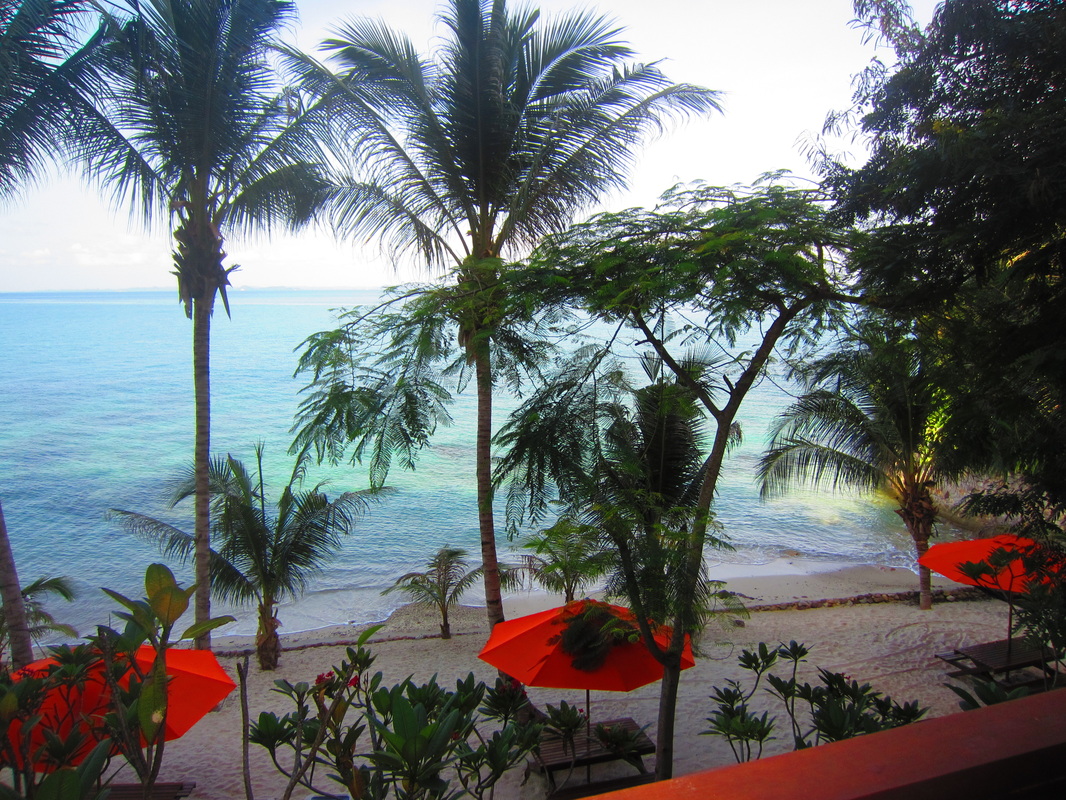
View from our room
|
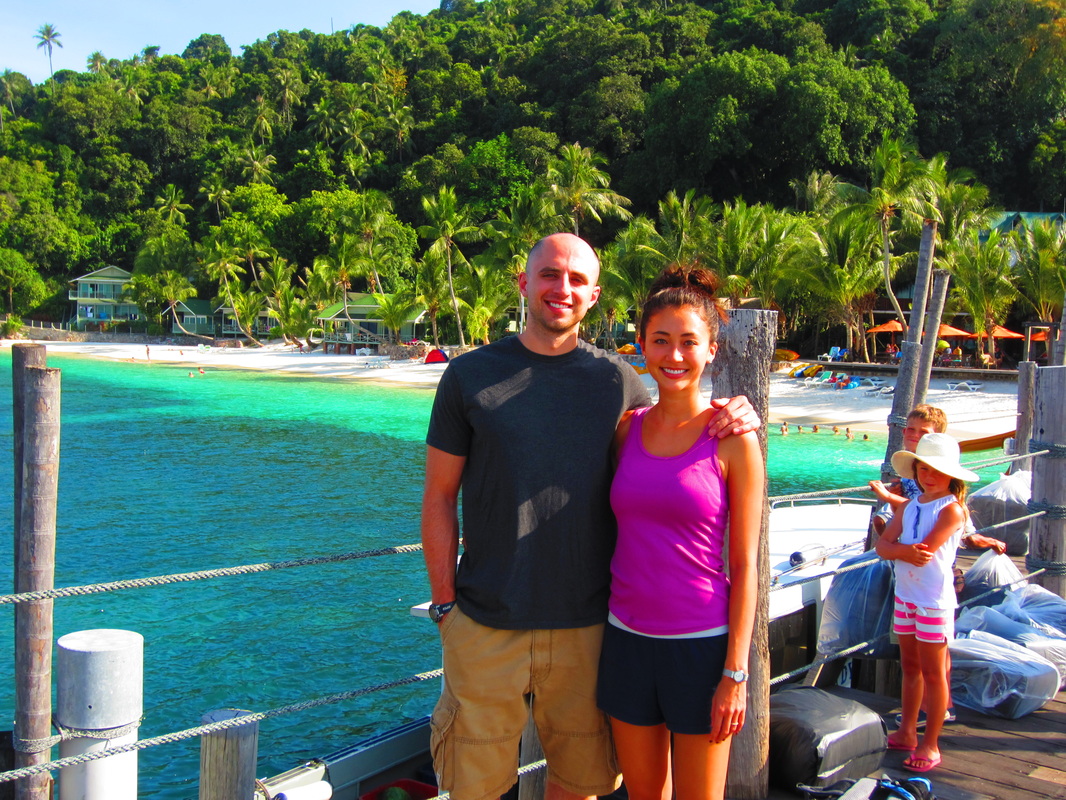
Waiting on the pier for our boat to take us back to the mainland... bye Rawa!
|
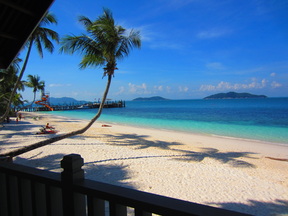 The view of Rawa's beach from our balcony Rawa Island is a remote little paradise off the west coast of Malaysia. We first heard about this gem while vacationing in Jamaica this past July. An executive from Exxon Mobil raved about the beach on Rawa and said it was his favorite place to vacation when he lived in Singapore. So, Joe and I decided to give it a whirl.
Our journey to Rawa began with an early morning taxi ride that took us three hours north of Singapore to the port of Mersing in Malaysia. The border crossing between Singapore and Malaysia is very impressive and efficient. Once we got to Malaysia, we switched cars. For some reason, taxi companies don't drive Singapore-registered cars through Malaysia, so we had to switch to a Malaysian car. The difference between the two cars was comical. In Singapore, we were picked up by a really nice, clean car with tinted windows. Our Malaysian car was a taxi that must have been built before 1980... it looked like it was falling apart and didn't have seat belts. I panicked a little bit because I was worried about getting stranded in the middle of nowhere, but I didn't let this fear get in the way of our adventure.
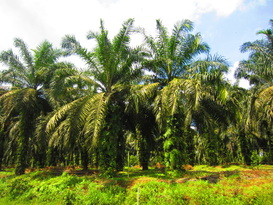 Palm plantations along the highway in Malaysia Our drive through the Malaysian countryside was both beautiful and gut-wrenching. On the positive side, lush, green palm tree plantations lined the highway and gave us a breathtaking view. I kept thinking how different the sight was compared to the cornfields and soybean fields of the midwest. On the negative side, our driver had no fear and drove like a bat out of hell. He weaved in and out of traffic as he passed cars on the two-lane road, gunning the poor engine that sounded like it would blow up. To make things worse, the road was very windy, and every time our driver took a turn he drifted over into the opposite lane. Joe managed to fall asleep on our drive, but I was too nervous to shut my eyes.
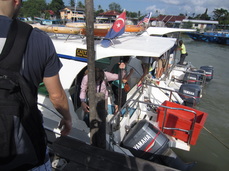 Boarding our speedboat in Mersing Despite the dangerous ride, we made it safely to Mersing Port where we boarded a speedboat that took us to Rawa Island. Rawa is about 30 minutes away from Mersing. While the ride was a little choppy, the view along the way was spectacular.
As we approached Rawa, I could see why the executive from Exxon had fallen in love with the island. The island is very small with a tiny stretch of beach. The beach has bright white sand that is as soft as powder and clear aqua water.
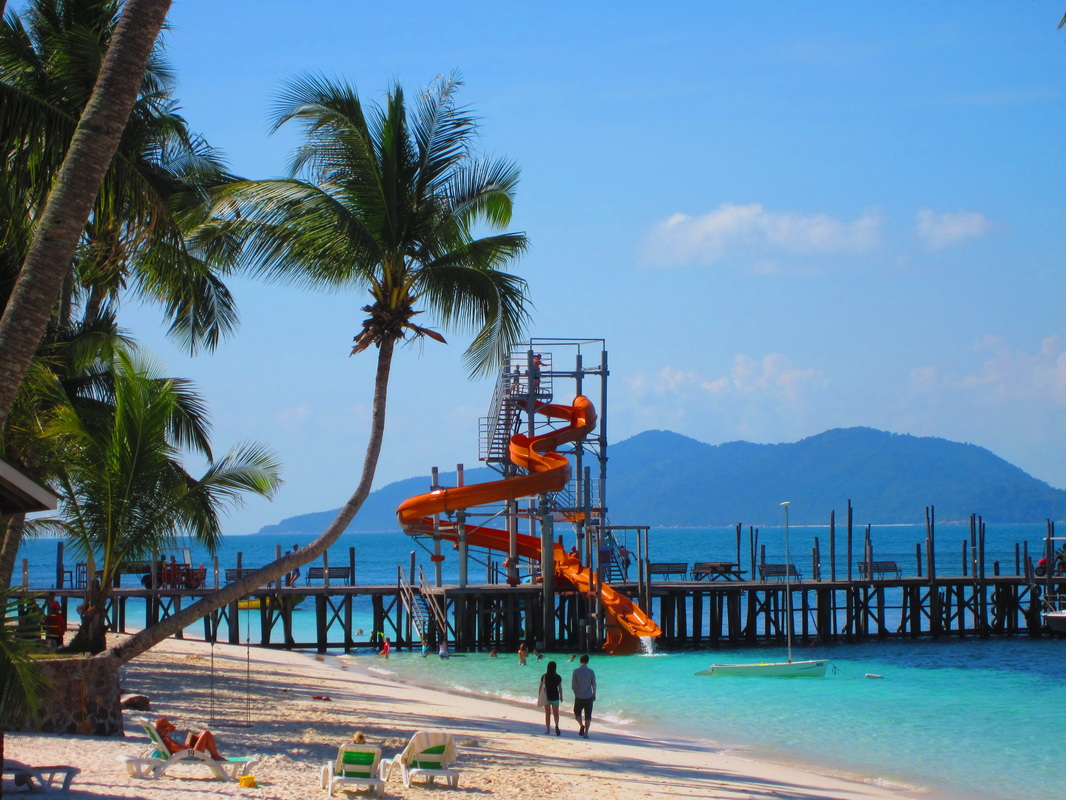 Rawa's pier and waterslide | 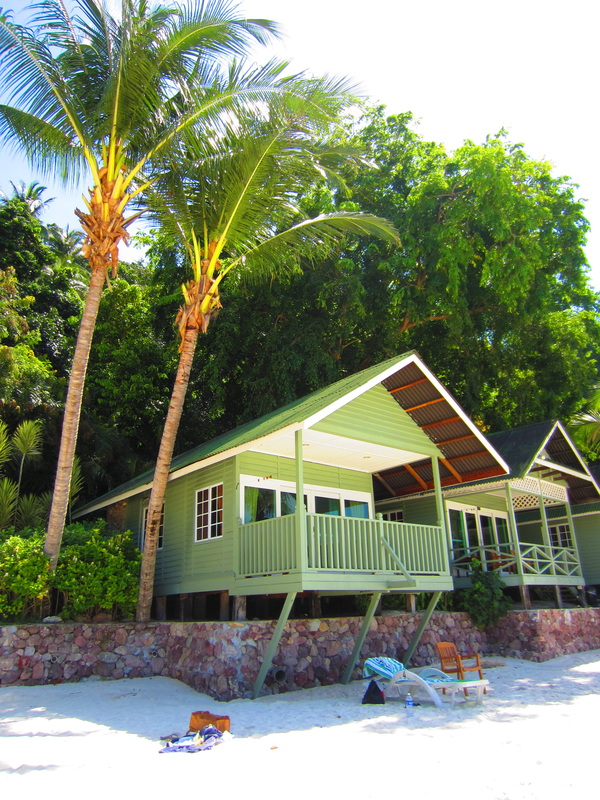 Our private bungalow on the beach | 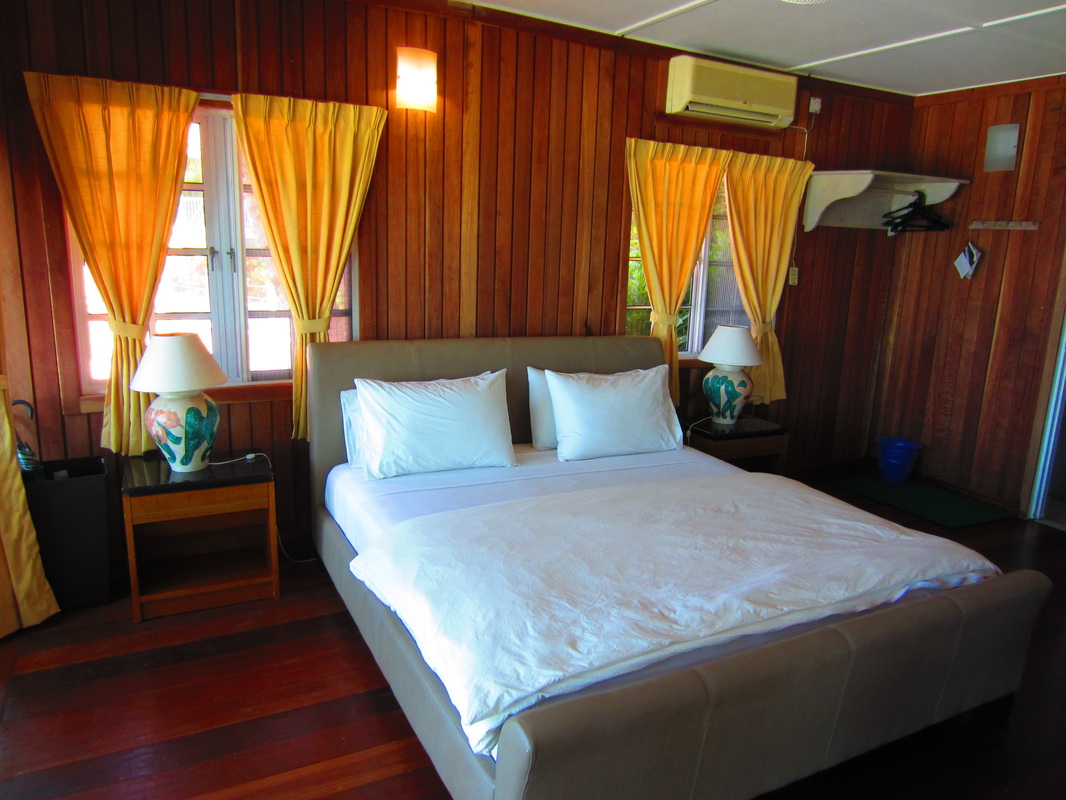 Our bedroom | 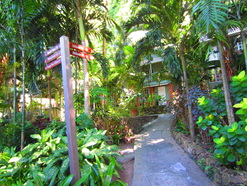 Our tropical setting The best thing about Rawa is that it is extremely undeveloped and the island's wildlife has been largely undisturbed. It was neat to visit a so-called raw island where civilization hasn't totally commercialized every inch. Rawa doesn't have a town with stores... there are only two very basic hotels. Alang's Rawa is sort of a beach bum hangout where people can camp on the beach or stay in a bungalow that doesn't have air conditioning or hot water. Rawa Safaris is the island's resort, with slightly better accommodations.
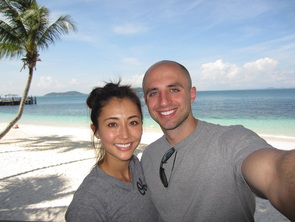 Sweaty, but happy! We stayed at Rawa Safaris... and I say slightly better accommodations because the resort is old and some of the rooms need some major renovations. Joe and I rented a private bungalow on the beach (see photo above) that had an amazing view. However, it needed some work. The air conditioning in our room did not work well and provided no relief from the hot, humid weather. This made for a very uncomfortable night of sleep (yes, we are spoiled and admit it!). The floorboards were not sealed well, so we could see the beach through the cracks. And the bathroom needs a major overhaul.
However, given that the point of a beach vacation is to actually spend it on the beach, we took the bad with the good and enjoyed our time on the resort. We gave in to the fact that we would be a sweaty, sticky messes throughout our vacation. And, after experiencing this, I have to admit it was kind of fun being disconnected from society and grubby like children. It's a liberating feeling to enjoy yourself without worrying about your appearance (I'm sure everyone else on the resort felt this way!).
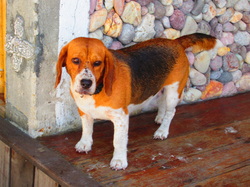 Daisy the resort's dog And a Lopez vacation wouldn't be complete without befriending the local creatures. In this case, Daisy the resort's beagle (and no, I didn't name her... this was her real name!) took a liking to us. In fact, the first day we had lunch on the resort, she followed us back to our bungalow. It was really cute because we couldn't tell if she was going to walk the entire way with us, but ended up running up to our porch before we even got there! Perhaps she could smell our stuff in the room.
Our first day on Rawa ended with a relaxing mix of frolicking in the ocean, relaxing on our porch, and enjoying the view of the ocean. It was a needed getaway from the hustle and bustle of Orchard Road!
|